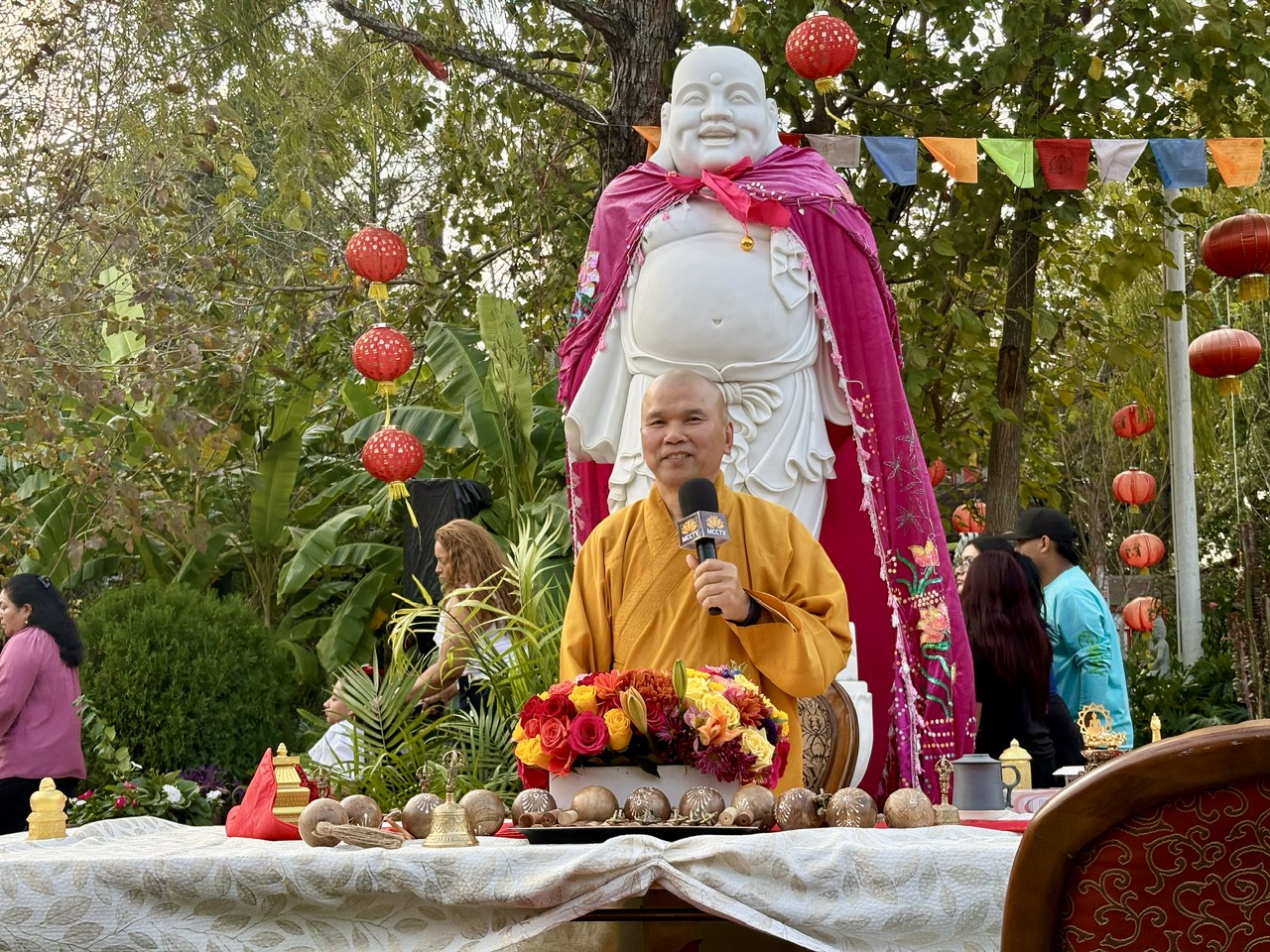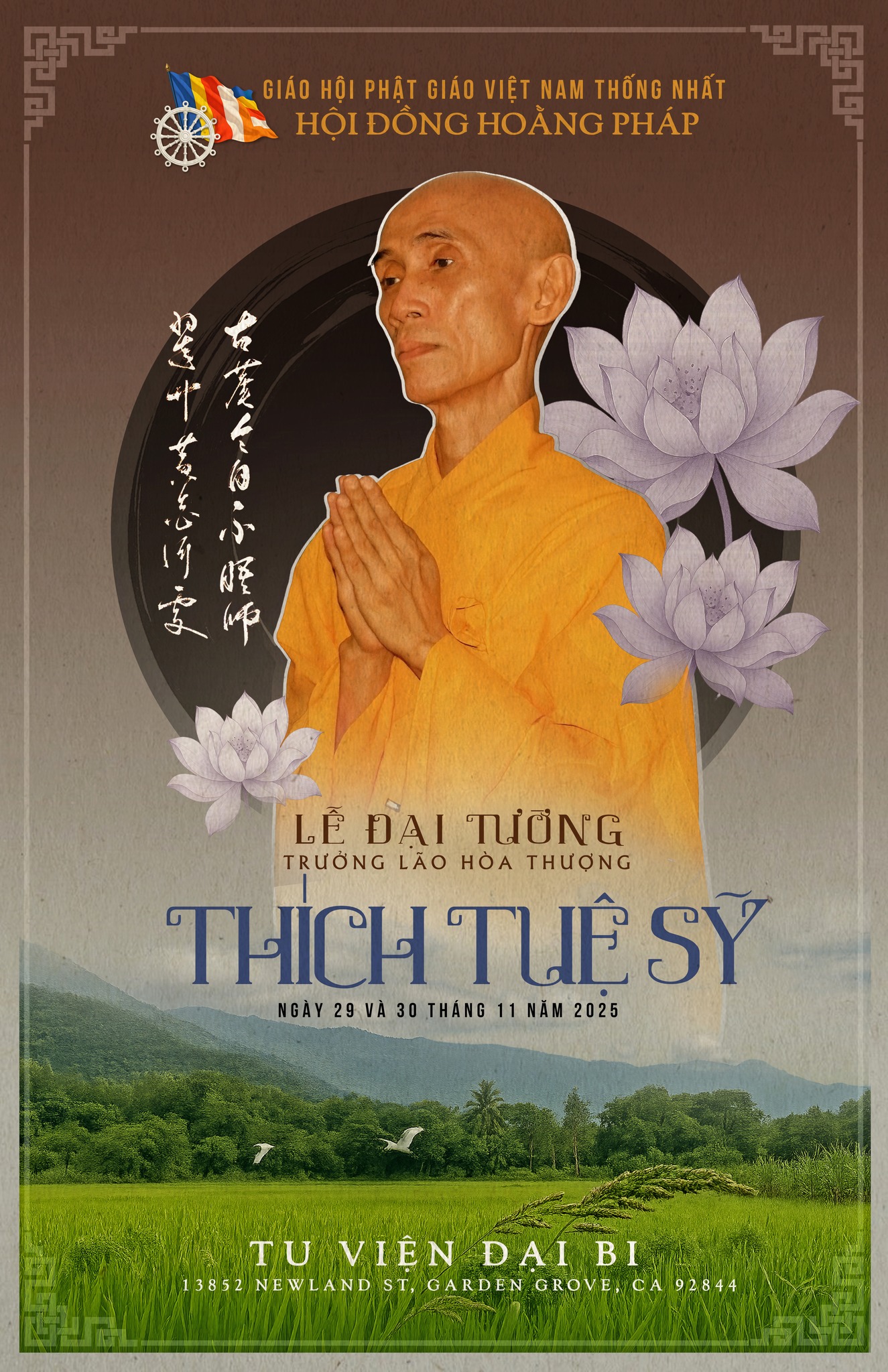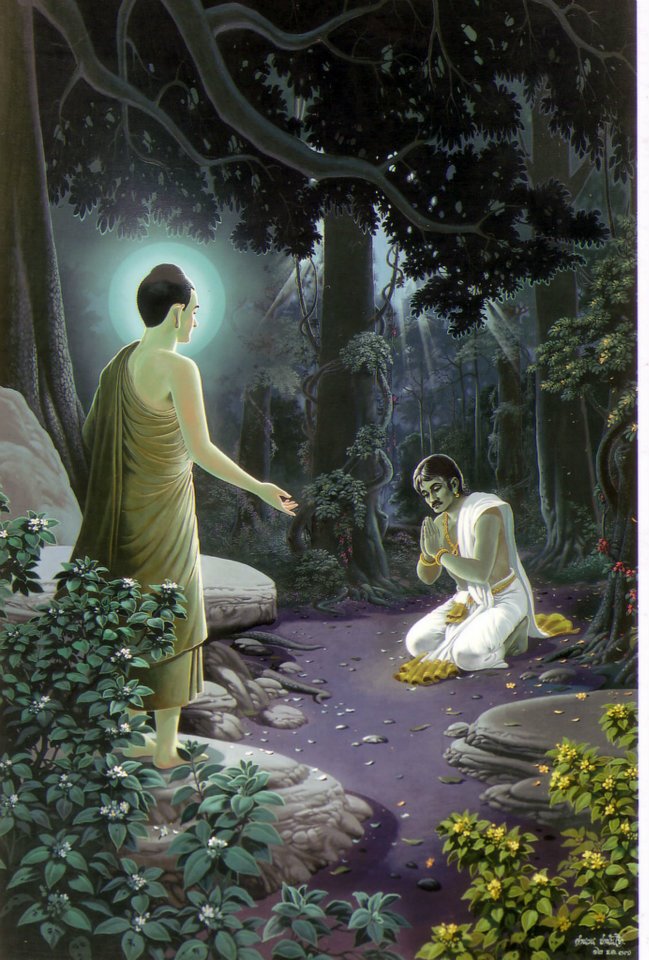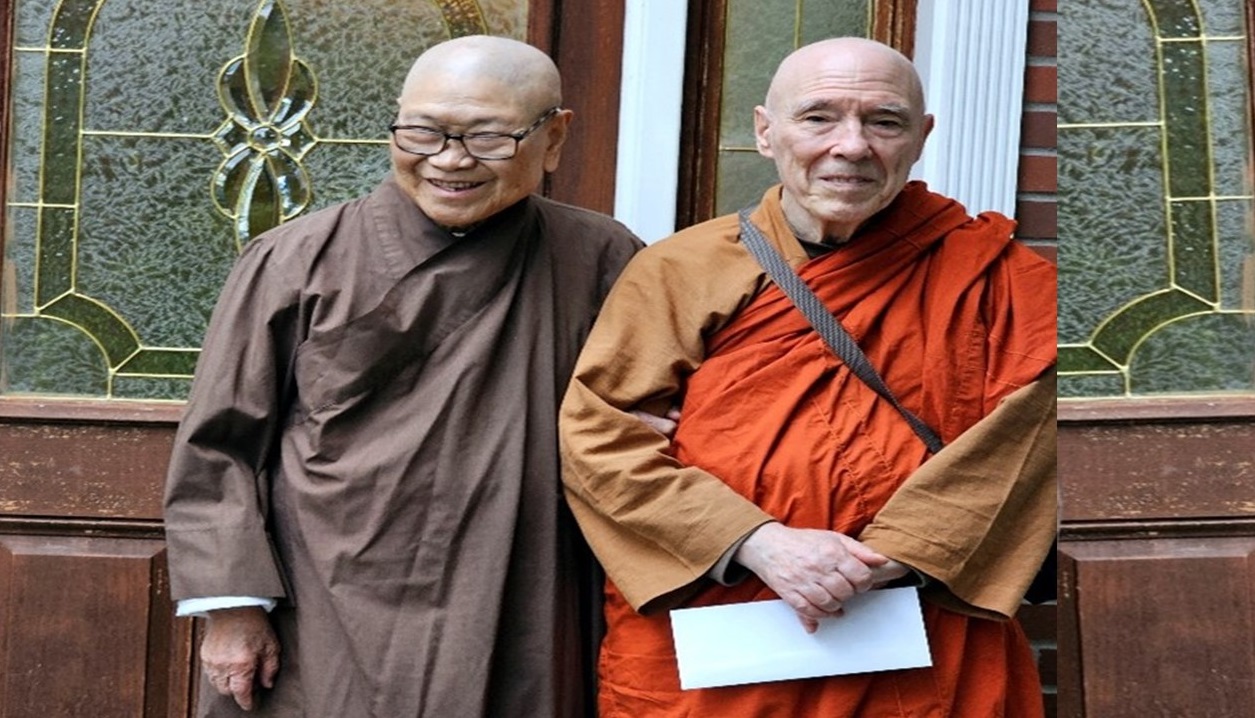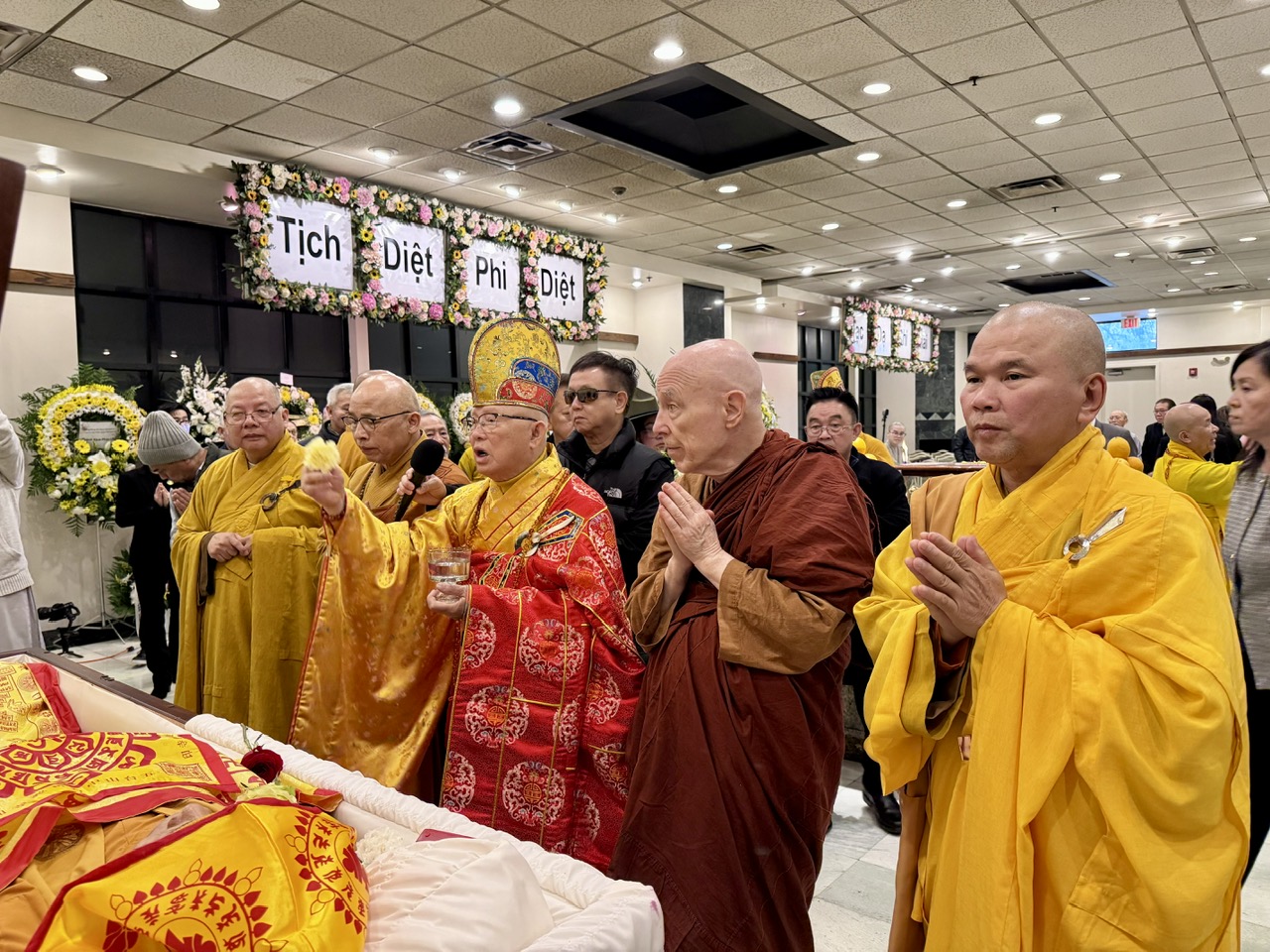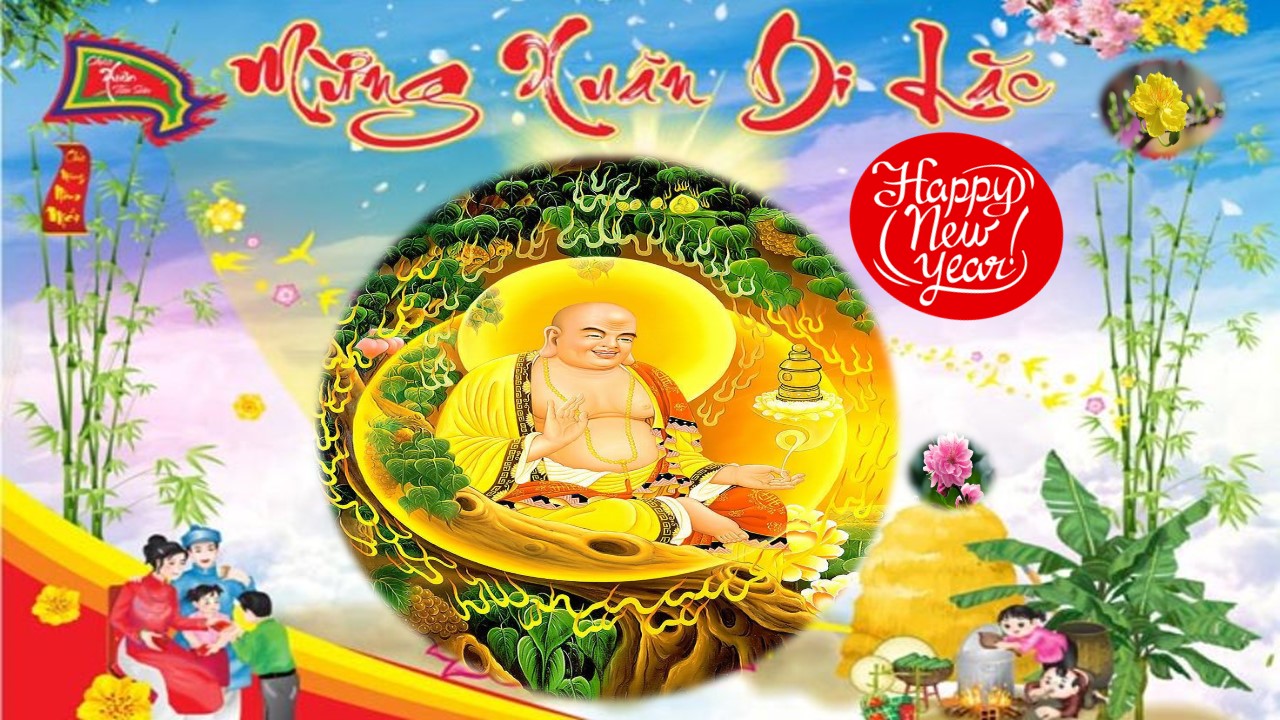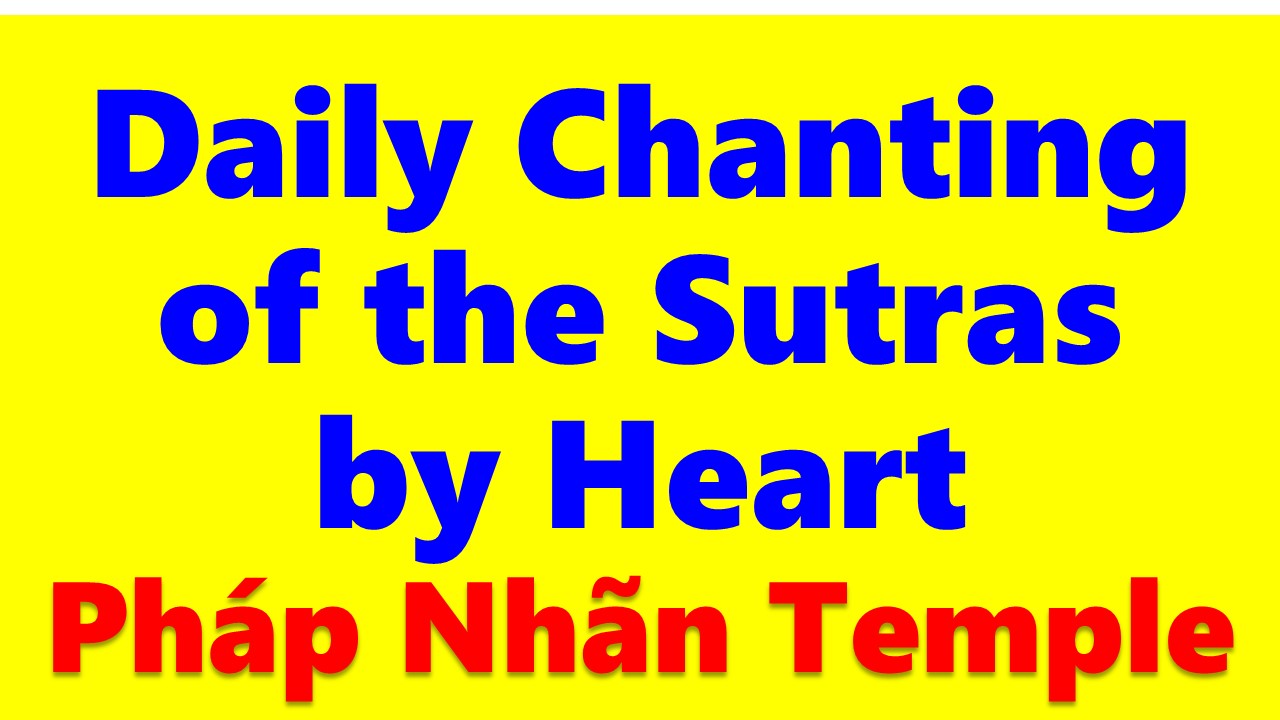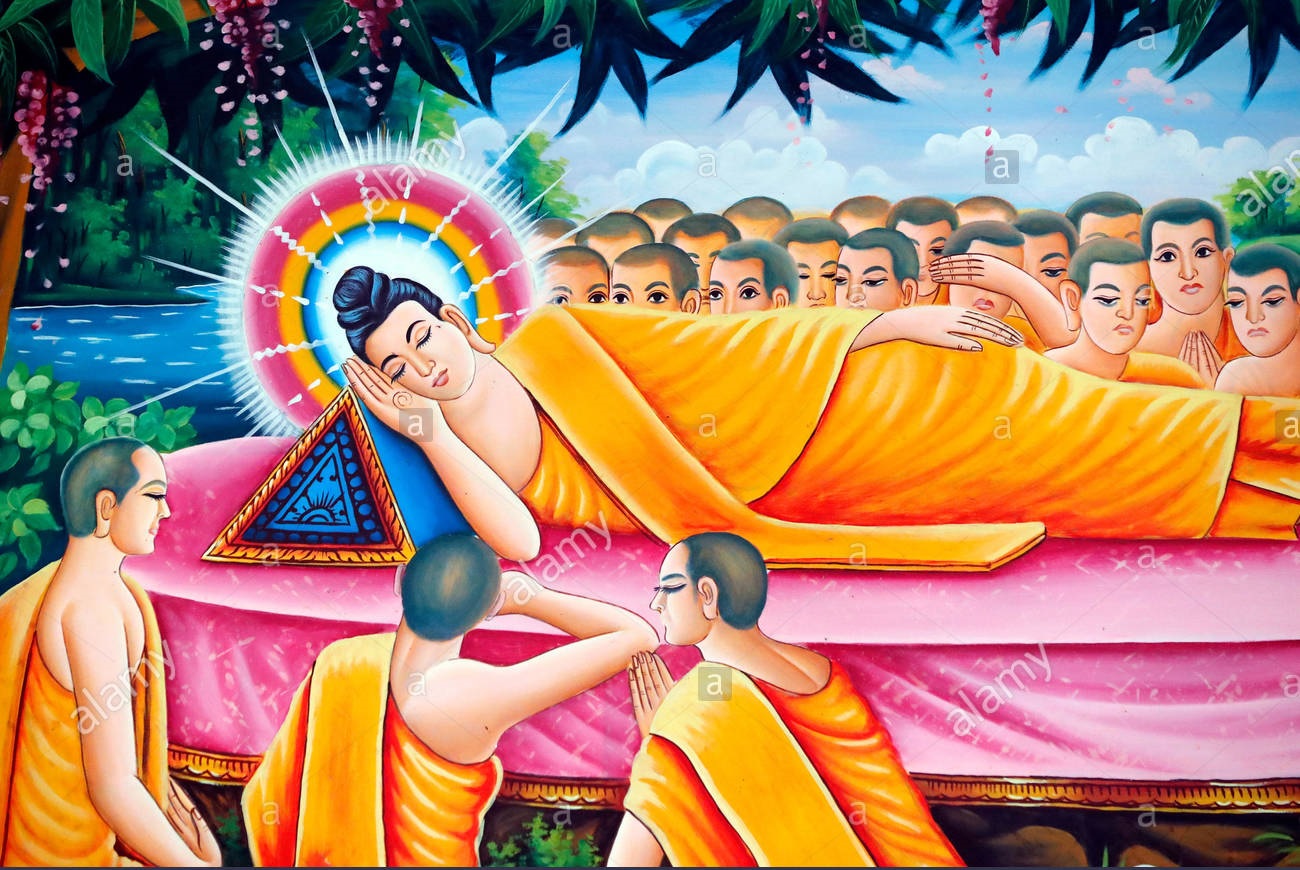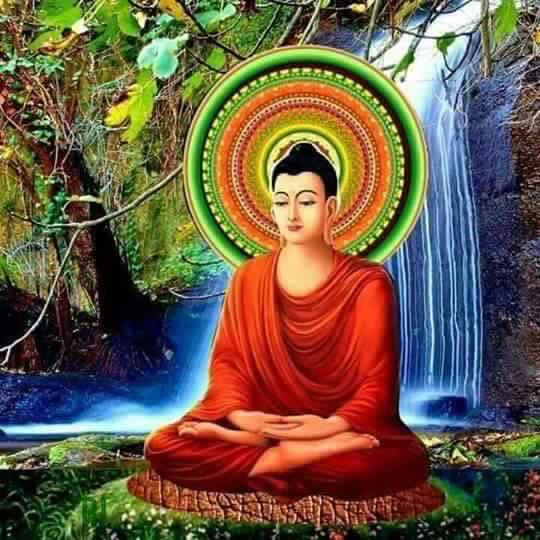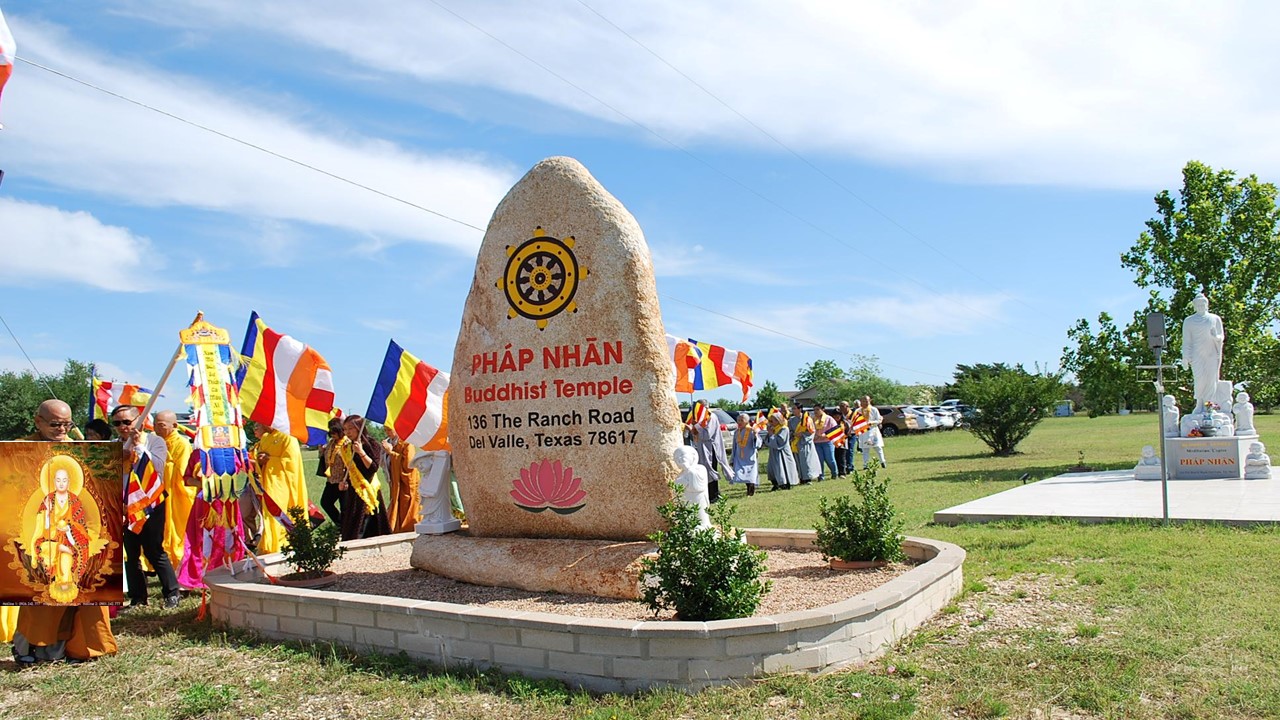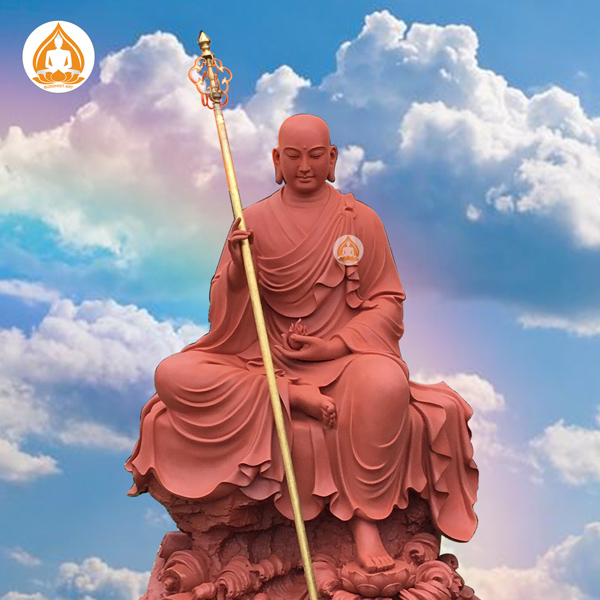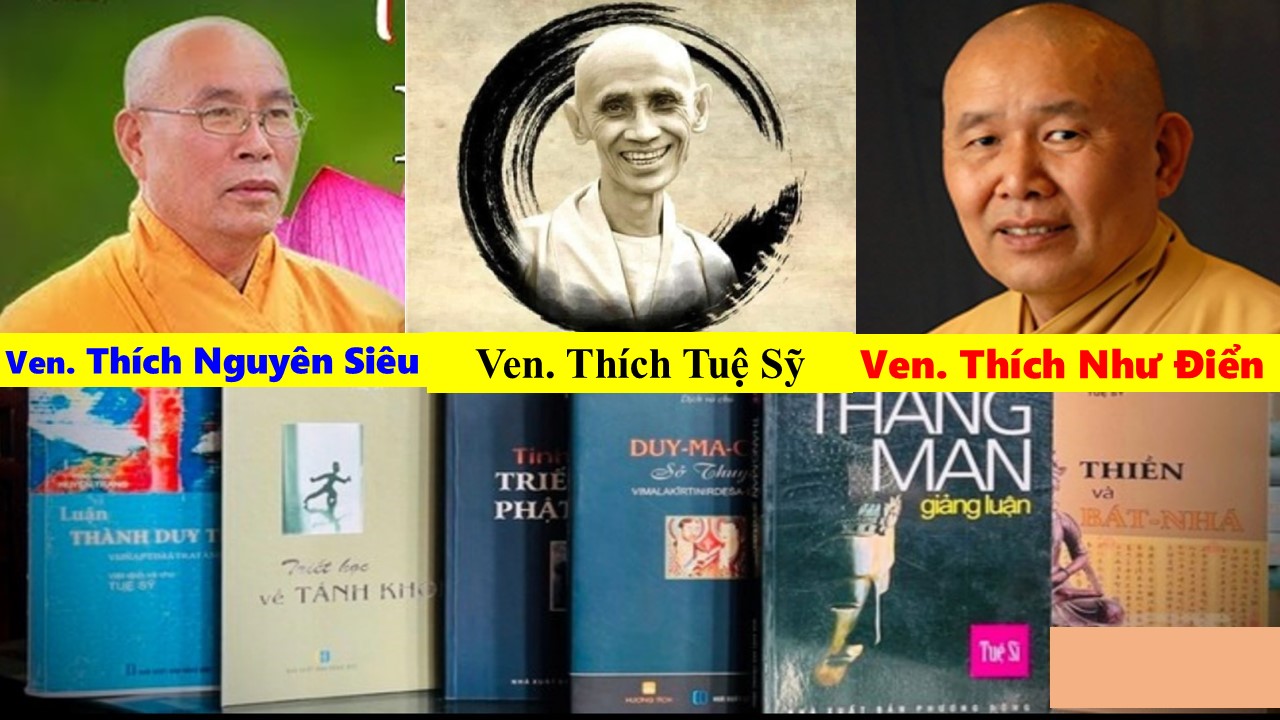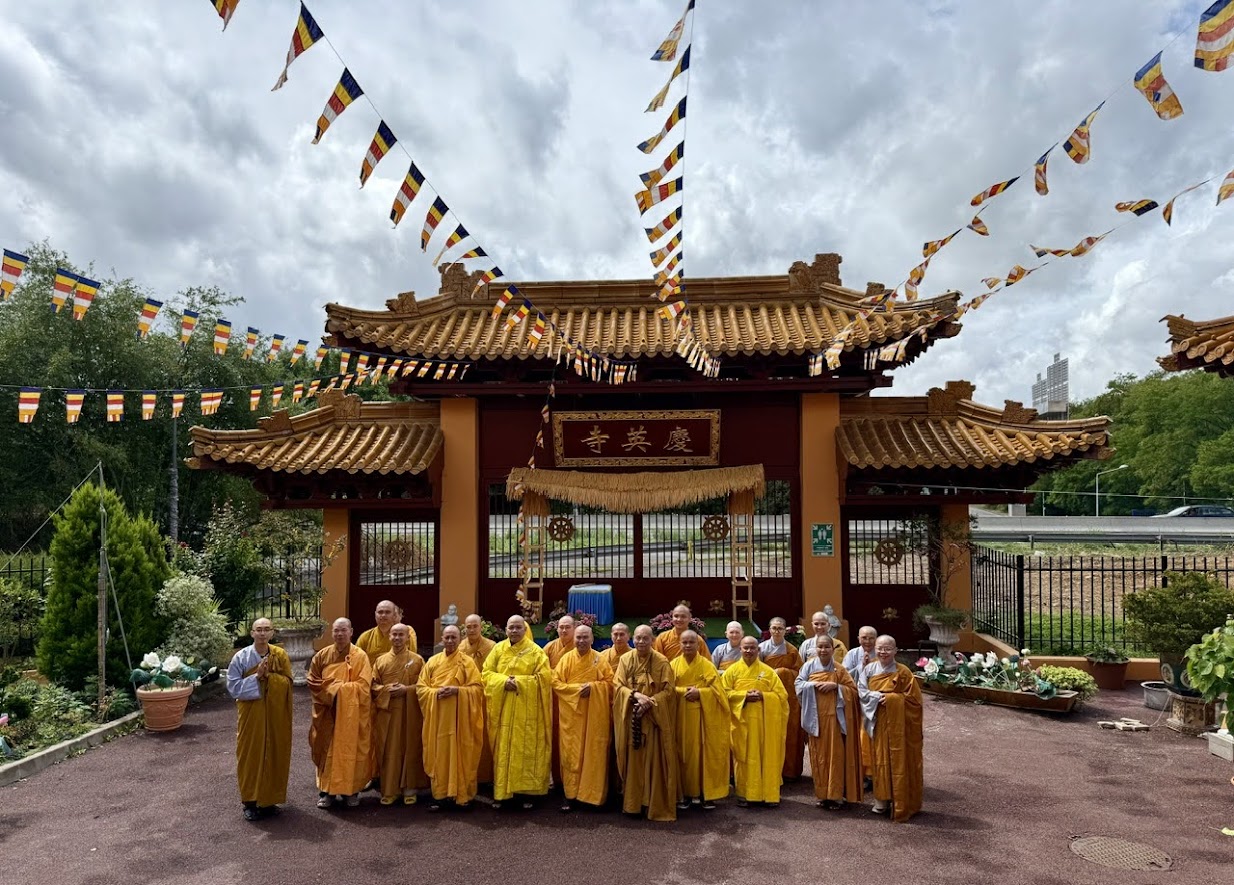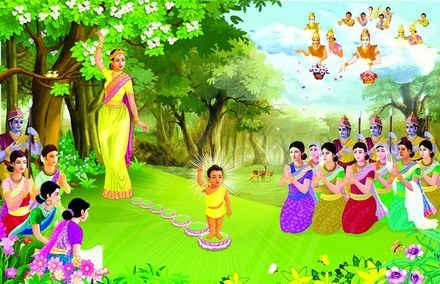
LOOKING AT THE BUDDHA’S BIRTHDAY THROUGH THE CONTEMPLATIVE EYES
When we think about the birth of a person, that of a Saint, or the birth of a Buddha, we can see it as the formation, beginning, continuity, transition, continuation, etc., of one’s new life. Normally, the first day when a human being, a Saint, or a Buddha is born is generally called the day of birth, date of birth, or birthday; birthday of the person called human birthday, that of the Saint called Saint’s Birthday, or the birthday of the Buddha called Buddha’s Birthday. Out of the power of rebirth Karma, a being was born in the world; out of the powerful vow of saving and helping human beings, the noble Saint or the Buddha manifests to be born in the world. Buddhism, which is the path of awakening, loving-kindness, compassion, wisdom, equality, and peace, has its source in the Buddha’s Birthday and his enlightenment.
Sakyamuni Buddha, a historical and actual Person of the flesh, was born in this world nearly three thousand years ago under a sorrowless (Ashoka) tree in the Lumbini garden, a part of Nepal today. In 249 B.C.E., this event,[1] which was engraved on a commemorative marker by King Asoka, was clearly written in the Agama Sutra as follows: “A unique being, an extraordinary person, appears in the world, out of peacefulness for the many, out of happiness for the many, out of peacefulness and well-being for gods and human beings, the being is mainly the historical and actual person – the Sakyamuni Buddha.”[2]
In this writing, nine different visions of the Buddha’s Birthday will be discussed as follows: Bottom of Form
- Looking at the Buddha’s Birthday via aspects of the historical person
- Looking at the Buddha’s Birthday via aspects of metaphor, legend, emphases, etc.
- Looking at the Buddha’s Birthday via the symbols of the lotus flowers
- Looking at the Buddha’s Birthday via aspects of the supreme person
- Looking at the Buddha’s Birthday via aspects of the normal person
- Looking at the Buddha’s Birthday via aspects of endurance, wisdom, leading to upper, to good, enlightenment, peacefulness, and liberation
- Looking at the Buddha’s birthday via aspects of watering, nourishing, arousing, and awakening Buddha nature in all living beings
- Looking at the Buddha’s Birthday via aspects of equality
- Looking at the Buddha’s Birthday via aspects of peace
- Looking at the Buddha’s Birthday via aspects of the historical person
Siddhārtha Gautama, an actual historical personage, lived on our earth nearly three thousand years ago. When he was born on seven days, his mother, namely the holy Mother Maya Māyādevī passed away. The prince’s stepmother was Mrs. Mahāpajāpatī Gotamī, who took care of him very wholeheartedly and thoughtfully. The prince’s father was named King Suddhodana. When the Prince was grown, he married princess Yasodharā, and had only one son named Rāhula.
Although living in the lap of luxury, wealth, and happiness, but the prince feft confirmed, unfree, uncomfortable, and finally, along with his companion named Channa, he made a trip out of the four gates of the royal palace to visit the real world outside. Getting out of the gates of the palace, going to the East, the prince and Channa met an old person; going to the West, they met a sick person; going to the South, they saw a dead person; and going to the North, they met a mendicant.
Of the four real scenes that the prince witnessed, the fourth was the image he liked best; the mendicant’s image was untroubled, leisurely, carefree, light-hearted, and relaxed. This image, which became engraved deeply in the prince’s inner mind, led him to taking up a life of contemplative meditation later on, help him to become a homeless monastic, living without a family and being not bound by the ties of his royal family and descendant.
Leaving home for a religious life at the age of 29, the hermit Siddhārtha, learned religion from two ascetics: Alara-Kalama and Uddaka-Ramaputta, spent six years practicing asceticism with the five brothers of the honored Elder Kondañña, and saw that their ascetic practices and religious attainments were prejudiced, aberrant, and imperfect. He decided to leave them and to choose himself the Middle Way (Majjhimāpaṭipadā) by practicing ways of non-self-indulgence and non-self-mortification.
After having eaten a milky porridge bowl given him by a young lady named Sujata, Bodhisattva Siddhārtha received a bunch of grass (Kusa) from a farmer, went straight to Bodhgaya, and sat in meditation under a Bodhi tree throughout 49 days and nights in various areas. Finally, the Bodhisattva achieved Enlightenment and became the Buddha called Sakyamuni at the age of 35.
Counting according to the Buddha’s Birthday or the birth of the Prince Siddhartha in about 624 BCE, taking the year 624 plus this year, namely in the year 2025, we have the 2649th Buddha’s Birthday. Siddhartha means a fully contented and perfect person has enough merit and wisdom. Counting according to the Buddhist calendar or to the Buddha’s passing away in the year 544 B.C.E. (624 B.C.E. – 80 = 544), taking the year 544 plus the current year, namely this year 2025, we have the Buddhist calendar year 2569. Sakyamuni Buddha is the founder of Buddhism: the path of awakening, that of peace, equality, loving-kindness, and that of wisdom.
Sakya is his clan; Muni is a peaceful and free Monastic. Thus, Sakyamuni, the Sakya clan son in Kapilavastu capital, had much peacefulness and happiness, steadiness and leisureliness, love and understanding, and left his royal palace for a monastic life to cultivate, to attain enlightenment, to lead to light-heartedness and deliverance, and to bring authentic peace, joy and happiness to living things and living beings all over the planet.
Spreading the Dharma for 45 years, passing away at the age of 80, the Buddha taught very many different kinds of people such as kings, mandarins, royal officials, merchants, servants, even dung-collectors, bandits, and courtesans. Those who have enough their good opportunities are able to learn Buddhism, listen to the Dharma, practice the Buddha’s teachings, and live their lives of mindfulness and awareness, and then peacefulness and happiness have the ability to instill, to calm, and to cool their bodies and minds.
According to correlative and interdependent vision, we see an actual historic person, that person becoming the Buddha, preaching the Dharma, and entering Nirvāṇa, – these two are one, and one is two, similar to water and its wave, and wave and its water; both of these persons are each other and cannot be separated.
Living his whole life in harmony with the natural environment, a newborn Siddhārtha prince, namely a newborn baby Buddha, was born under a sorrowless tree in the Lumbini garden, obtained enlightenment under the Bodhi tree at Bodhgaya, preached the first Dharma Sermon – the Four Noble Truths to the five brothers of the honored Elder Añña Kondañña in the Deer park – Sarnath, and passed away under the twin trees in the Sala forest in Kusinagar district.
These are the four most important holy places of Buddhism that are to represent the Buddha and the life of His, always living to protect the natural environment thoughtfully, peacefully, freely, and leisurely.
“As bees that go to find flowers,
rely on flowers to suck nectar,
only suck nectar and then fly away,
but they do not damage the perfume and beauty of flowers.”[3]
Flowers are an example of the natural environment; nectar is a symbol of Dharma learning, Dharma practice, Dharma understanding, Dharma joy, and Dharma flavor; bees are symbols of the Buddha and His disciples, knowing how to rely on the natural environment to live, to rejoice, to cultivate, to do mindful activities, and to rely on the Buddha, the Dharma, and the Sangha in order to build happiness, love, and peace for the many all over the planet.
Having briefly looked at the Buddha’s Birthday via the aspects of Him as an historical person,[4] we are next going to continue to learn about the specific following features of the Buddha’s Birthday.
- Looking at the Buddha’s Birthday via the aspects of metaphor, legend, emphases, etc.
When looking deeply at the Buddha’s Birthday, we see specific characteristics of Buddhism have very many important meanings for us to learn. The Jàtaka[5] story stated that queen Maya and king Suddhodana were over 40 years old when they had their first and unique son.
Normally, spouses live and eat together about one year or many years, whether girl or boy, they expect to have one or two children to maintain the continuity of a family temple and to maintain the career of spiritual ancestors and blood ancestors. When their first child is born, spouses and families of maternal and paternal sides are very happy because the child is the result of the couples’ love.
Queen Maya and king Suddhodana desired to have their child to connect the royal career of Sakyan clan. Their desire was fulfilled, that is to say, they had their first-born son. Three days after the prince was born, the seer Asita was invited to enter the palace, and he performed a ceremony of naming the prince Siddhartha; Siddhartha, means the fully-contented man who has sufficiency of merit, virtue, and wisdom has the ability to become a peaceful, awakened, and relaxed monastic, to bring Buddhism into life, and to help add joy, and reduce suffering to life.
During the time of bearing the holy pregnancy, the king and the queen, along with royal people in their royal court, always did good things, said good things, and thought of good things to permeate, to penetrate, and to water them into the fetus’s immaculate consciousness. These good things have the ability to penetrate deeply into the fetus’s mind and consciousness, to help the fetus have the capability to nurture, to develop, and to form the attributes of equality, peace, loving-kindness, compassion, and wisdom later. Their thoughts and acts, which contained many meanings very positively and practically, brought much peacefulness and happiness to themselves, to the fetus, and to the many. This is the first fetal education – extremely valuable and precious for human life.[6]
Thus, we see during the time of bearing the fetus, both the king Suddhodana and the queen Maya, along with mandarins in their royal household, attempted to cultivate by doing meritorious and good things, and bringing many benefits to themselves and to the many. Practicing like this, families not only achieve happiness, but the fetus also obtains peaceful joy. This is the catalyst of power, peacefulness, and happiness constituting and nurturing the seed of the holy fetus to sprout, an infant Buddha was born.[7] Dhammapada, Verse No. 194 states:
“Happy is the birth of the Buddha,
Happy is the noble Dhamma,
Happy is the harmonious Sangha,
Happy is the Four Assemblies cultivating the Dharma together.”
In Buddhist Texts, to describe the marvelous birth of a Buddha, namely Lord Sakyamuni Buddha, historians later often embellished the aspects of his legend, solemnity, reverence, sacredness, and miracle. These aspects, which contained the metaphorical meanings, were used to describe when Queen Maya had her holy pregnancy; it is said she had a good dream in which she saw the Bodhisattva Vesantara come from the Tusita heaven, riding a white elephant with six tusks, and entering her righ hip, whereupon she became pregnant.[8]
The Tusita heaven is the place from where Bodhisattva Vesantara[9] starts and descends; At this point, we see that Buddhism also accepts the concepts the realms of heaven and gods.[10]
According to the specific viewpoints of Buddhism, God is also a being in the form of the great blessed rewards. Depending on their actions which create good and no good, living beings can be born in the realms of heaven, human beings, Asuras, hells, hungry ghosts, and those of animals.
In the realm of heavens, beings experience only happiness. It is very hard for them to cultivate. They only know enjoyment, so they have no motivation to escape from suffering.
In the realm of human beings, beings have both suffering and happiness. It is the best opportunity for beings to cultivate, to progress to enlightenment and deliverance, to help oneself and help others.
In the realm of Asura, beings are very angry and hot-tempered. It is easy for them to cause war endlessly.
In the realm of hells, beings are executed, imprisoned, and tortured.
In the realm of hungry ghosts, beings are trembling, hungry, thirsty, desiring, and grasping.
In the realm of animals, beings make mincemeat of one another.
In three realms of hells, hungry ghosts, and animals, beings are always tortured, suffering, and miserable. They rarely have or have no time and no opportunity to cultivate.
Indeed, according to practical teachings of Buddhism, living beings in the six realms are created by their own bodily actions (Karma), verbal actions, and mental actions right in the present life. Creating good actions, beings are reborn in the realms of heaven or those of human beings; creating non good actions, beings are reborn in the realms of Asuras, hells, hungry ghosts, and animals.
Beings in heaven have more blessings than beings in other realms. Out of his vow to help beings, from the realm of Tusita heaven, Bodhisattva Vesantara was present in this earth by way of being reincarnated as the king Suddhodana’s and queen Maya’s son, namely prince Siddhārtha.
According to philosophy of interdependence and co-arising of Buddhism, the father’s sperm, the mother’s ova, her womb, the parents’ intimacy, the time of her conception, pregnancy, etc., are very important and necessary factors to form a fetus. Besides those factors, in the process of forming and developing, the fetus must still depend on other necessary elements such as light, air, warmth, motion, nutrition, etc., especially on the presence and the re-link with reincarnation consciousness (Patisandhi viññana)[11] or Gandhabha.[12]
In many lives of the past, the present, and the future, depending on the powerful vow and powerful Karma (action) of every human being, this consciousness connects, unites, integrates, borrows, and rely on five aggregates (form, feeling, perception, volitional formation, consciousness) of parents to form a fetus. In the cycle of birth, death, and rebirth, about nine months and ten days, the fetus will be created, linked, grown up, gotten old, passed away, and continue transferring to another life, finally being born into its new life.
In the case of the birth of Bodhisattva Siddhārtha, with finally transitional life of Bodhisattva Vessantara,[13] out of the powerful vow of teaching and helping living beings, coming from the Tusita heaven, the latter embodied as the baby Buddha. To practice and to remember his conduct and vow of teaching living beings, in the season of the annual Vesak ceremony, celebrating the Buddha’s Birthday, monastics and lay people usually praise, kowtow, and prostrate themselves in front of Him:
“Bodhisattva Vessantara,[14] who comes from the realm of Tusita heaven, imparts a good omen in a dream to queen Maya, rides a white elephant with six tusks, and enters her right hip. Or a newborn baby named Siddhartha, who was born under a Sorrowless Tree, is present in the world to bring peacefulness and happiness to the many, is sprayed water by nine dragons, walks seven steps on seven lotuses, and bravely says: In heaven and on earth, only an Awakened and Enlightened Person is noble. All living beings have Buddha nature.”
All the above-mentioned words, such as elephant, white, six tusks, right hip, tree, sorrowlessness, figure 9, dragon, water, the number 7, step, lotus, person (Atman), are the symbols of metaphor and emphasis. The right hip is the symbol of legend; the legend here means that the story involves many solemn, respectful, sacred, marvelous, and wonderful meanings.
Elephant represents power, steadiness, calmness, carefeeness, and freedom; White symbolizes purity, cleanness, non-pollution; six tusks represent the six authentic conduct vows (alms-giving, precepts protection, endurance, diligence, meditative concentration, and wisdom) of a Bodhisattva entering his or her life to save living beings. Right side is the clockwise oriented side, going from the East to the South, the West, and to the North. The right side represents the direction of favorable conditions, that of bringing the Buddha’s teachings to life in order to help add happiness and relieve suffering to life. The right means the good, reason, the truth, etc. Being born on the right side of Queen Maya’s hip brings the meanings to the mythological symbol. In fact, the prince Siddhārtha was normally born as everyone else in the world.[15]
We know the right side hip is true opposite to the left side hip bringing symbolic meanings to show the favorable conditions, suitable to truth and reason. This point is emphasized and reminds us that as person of four elements (earth – hard substance, water – circulating substance, fire – heat substance, and wind – movement substance) and five aggregates (form, feeling, perception, mental formation, and consciousness) like the prince Siddhārtha, each of us will have the ability to cultivate, to obtain enlightenment, and to be freed like him if each person tries to live her or his life of mindfulness and awareness, steadiness and calmness in the daily life. No one or no god can replace the person in this effort.
Bodhisattva Vessantara,[16] who rode the white elephant with six tusks, entered the right side hip of the Queen Maya; the right side hip brings the meanings of symbol, metaphor, and emphasizes that an enlightened and awakened One that wants to bring the Buddha Dharma to life in order to teach human beings has practiced the six conduct vows to save living beings: “Alms-giving, precepts protection, endurance, diligence, meditative concentration.” When the six conduct vows of saving living beings are performed perfectly and sufficiently, the Bodhisattva has the ability to help add joy and happiness to life.
The Bodhisattva here is personified and actualized in the prince Siddhārtha, who was born, grew up, left home for a religious life, led his monastic life, obtained enlightenment, preached the Dharma, and saved living beings right in this life. Integrating into the world to teach human beings, but he is not polluted by the world, his body and mind always uphold calmness, mindfulness, steadiness, cleanness, and purity. To follow the World-Honored One’s example, to apply, and to practice His conduct vow of teaching human beings, each of us is each peaceful practitioner, each of us is an authentic Bodhisattva, bringing Buddhism to the world in order to help it be peaceful and happy.
(Bodhisattva Vessantara[17] – the past life of Sakyamuni Buddha)
Looking at the meaning analytically, we know that Bodhisattva in Sanksrit consists of two words Bodhi and Sattva; Bodhi means awakening, enlightenment, and Sattva means a being or a person. Thus, the Bodhisattva means that the awakened and enlightened One has the ability to awaken the Buddha nature of oneself and others to shine, has the ability to arouse and water the seeds of enlightenment of others to germinate, and has the ability to instruct others to practice, towards enlightenment and deliverance like oneself.
This is the specific point of Buddhism. In ancient time as well as in present time, those who have enough proper conditions to cultivate themselves can achieve peaceful joy, happiness, enlightenment, freedom, equality alike. Indeed, Buddhism always emphasizes and affirms that humane beings are supreme.
In the Sino-Vietnamese, the word “Hộ” in “Hộ Minh” is a verb meaning to keep, to protect, to maintain, to develop, etc.; the word “Minh” in “Hộ Minh”is a noun meaning lucidity, brightness, clear light, purity, purification, insight, illumination, shine, etc. Hộ Minh (Vessantara),[18] the Dharma title of Bodhisattva, who descends to earth, means that One has the ability to keep the insightful lamp to shine for the world, to bring authentic joy and happiness to the world. This person, who is embodiment of the prince Siddhārtha, namely that of Sakyamuni Buddha, has the ability to bring wisdom, love, equality, and peace to the many all over the planet.
On this occasion, we also learn about the meanings of the Sino-Vietnamese phrase “thị hiện đản sanh”; “thị hiện” means to be present in here; “đản sanh” means the birth of a holy One, namely the Sakyamuni Buddha. “Ở đây,” meaning “here,” here is is understood and exemplified as saha world indicating this earth, where we have been living, there are many calamities, wars, robberies, struggles, etc., happening. All those things are created by human hearts of lust, anger, delusion, arrogance, doubt, wrong view, etc.
The Buddha and Buddhism that have been present in this world are to teach and to instruct people to know how to cultivate, to transform desire, anger, delusion, to give up evil, to do good, to lead them to upper, righteousness, and good by practicing and applying the Buddha’s teachings into their daily lives, to live their lives of mindfulness and awakening, steadiness and liberation to bring peacefulness and happiness to the many right here in this world.
Likewise, out of loving living beings, out of bringing peacefulness and happiness to gods and to humankind, the Lord Sakyamuni Buddha has been embodied in the realm of this world, that is to say, present in the here and the now to listen and to share their grief, mourning, and suffering du to war and crime. He helps them to clearly see the way leading to peace, equality, love, and mutual respect by practicing the noble path with the eightfold lane highway, namely “Right View, Right Thought, Right Speech, Right Action, Right Livelihood, Right Effort, Right Mindfulness, and Right Concentration.”[19]
This eightfold lane highway is mutually supportive and has many interdependent relations with each other very closely; one is eight and eight is one. Indeed, the noble path with the eightfold lane has ability to build wisdom, love, and authentic peace for the many, and has the ability to lead living beings to the shore of peaceful joy and happiness for oneself and for others right in this life.
Through the above discussion, we see the phrases of the Vessantara Bodhisattva (Bồ tát Hộ Minh), the realm of Tusita heaven, the six-tusk white elephant, the hip of right side, and embodiment have been presented. Next, you are happily invited to together learn about the following words, such as the sorrowless tree, nine dragons, sprinkling water, seven steps, lotuses, strongly saying, and true self.
When being born under the Sorrowless Tree (Ashoka), the newborn baby named Siddhārtha or newborn Buddha took seven steps on seven lotus flowers, his right hand pointed out to sky, his left hand pointed down to earth, and strongly said: “All over the world, only true self, Buddha nature, that is, the enlightened One, is esteemed and respected. All living beings have Buddha nature.”[20]
As you know all the words and phrases of tree, sorrowlessness, nine, dragon, sprinkling, water, seven steps, lotus, strongly saying, etc., contain the meanings of symbols, metaphors, emphases.
The tree here symbolizes Queen Maya, who was over 40 years old, gave birth to an only son,[21] a holy infant, the newborn baby Buddha, a perfectly satisfied Person with sufficiency of virtue and wisdom; Less in sorrowlessness means empty or void; Sorrow means regret, sadness, trouble, affliction, defilement, etc.; Sorrowlessness means non-regret, non-sadness, non-affliction, non-delusion, etc. Thus, the sorrowless tree means the tree without regret, sandness, affliction, and defilement, and it is the symbol both for the holy Mother, Maya, and her newborn baby Siddhārtha.
Out of not being overcome by defilement and sorrow, the holy Mother, Maya has the ability to dedicate to earth a person of perfect awakening, enlightenment, freedom, namely the historic Buddha later named Sakayamuni. Out of not being subdued by defilement and affliction, the prince Siddhārtha had good conditions to be born in the world, to leave his royal family for a monastic life, to cultivate, to enlightenment, and to bring peacefulness and happiness to all living things and living beings.
According to contemplative and interdependent vision, the happiness of a mother is mainly her son’s happiness, and the joy of the mother is mainly joy of her child, that of her royal nation, and that of her people. The holy Mother, Maya, who was happy to nourish her holy fetus, gave birth to her holy and compassionately newborn baby, whose body and mind were not defiled by lust, anger, delusion,[22] etc., who became present in the world to bring infinite love and peace to the realms of living things and beings.
Whenever the seeds of holiness, peaceful joy, and happiness are inherent in the person of holiness, joy, and happiness, these seeds and this person can bring authentic joy and happiness to living things and living beings all over the planet.
Part 2 will be presented in part 9: Looking at the Buddha’s Birthday through the aspects of peace, I would like to invite you to follow the following parts of this writing.
- Looking at the Buddha’s Birthday via the symbols of the lotus flowers
Being born under the sorrowless tree, the newborn baby Buddha took the seven steps on the seven lotus flowers.[23] His steps are lifted up by the lotus flowers. These steps, which are authentically the steps of peace and happiness for the many, are a sign to us that the World-Honored One has been present in the world.
The pink lotus here symbolizes purification, purity, awakening, awareness, mindfulness, steadiness, and freedom. In this context, the lotus symbolizes the Buddha and His virtuous characteristics. The seven pink lotuses represent for the seven Buddhas:[24]
Vipassì Buddha, Sikhì Buddha, Vessabhù Buddha, Kankusandha Buddha, Konàgamana Buddha, Kassapa Buddha, and Sakyamuni Buddha. Consistently before and after like one, the seven Buddhas are full of the above specific characteristics.
“The pure step,” which means the step of peacefulness, purity, equality, love, and peace, represents the peaceful and happy, steady and light-hearted steps of the Buddha, Buddhism, and His disciples.
In the second verse, we encounter the words the lotus pond, the Lord of loving-kindness and compassion; the pond is understood as the world; the lotus symbolizes the Lord of loving-kindness and compassion, namely the Buddha, who has His immense and infinite love toward living things and living beings.
When referring to the lotus pond, we think of land, water, air, light, etc., especially the mud at the bottom of the pond. The lotus grows up in the pond, in the mud, it emerges valuable, pure, and clean even though it has never grown in clean water and land. This represents the purity of the Buddha, namely the prince Siddhārtha. Being born in the world, the prince who left royal home for a monastic life cultivated, obtained enlightenment, and became the Buddha.
Out of his wish for peacefulness and happiness for the many, out of his immensely vast love toward living things and living beings, He wished to be among them, giving them a good chance to meet Him, to learn the Buddha Way, to listen to the Dharma, and to respect the Sangha, He had the ability to educate and to teach them, and was beyond blame, praise, and criticism of the world. Depending on the world to preach the Dharma, to teach sentient beings, to bring peacefulness and happiness to them, the Buddha led his life of mindfulness and awakening, steadiness and freedom, peacefulness and happiness, reflected in his perfect gestures, speech, thought, and actions, esteemed and revered by the world. If He was born and lived in a realm of heaven, living beings on earth would not have known Him and would not have had the opportunity to adore and respect Him.
According to the tenets of Co-arising, the lotus is made of the various elements in which it grew, such as the mud, water, air, light, etc. Growing up in the mud, but the lotus is not defiled by the mud; it rises up to the surface of water, goes beyond the water surface freshly, blooms beautifully, and it produces full fruit. Likewise, living and spreading the Dharma in the world throughout 80 years, but the Buddha, who was not stained by the world, not controlled by ignorance and defilement, still dwelt stably in right mindfulness, right concentration, and right clear understanding in order to bring authentic peacefulness and happiness to himself and to others right in the present life.
At this point, the mud represents defilements of craving, anger, delusion, concepts of right, wrong, blame, and praise of the world; the lotus symbolizes the results of the Buddha’s effort, cultivation, and contemplative meditation. The process of cultivation and propagation of the Dharma is the process of helping practitioner identify and transform the mud into the lotus, defilement into Bodhi – enlightenment, suffering into peacefulness and happiness, etc. The Buddha has ever done so, and His disciples also have ever imitated and followed His virtuous conduct like this.
The more we learn and practice the Buddha Dharma, the more we obtain peacefulness and happiness; the less we learn and practice the Buddha Dharma, the less we obtain the results of peacefulness and happiness for ourselves and for other people. Not learning the Buddha Dharma, we do not know where the good path is to practice. Therefore, we each try to cultivate and to practice the Buddha Dharma well in order to bring flowers and fruits of peacefulness and happiness to many people.
Indeed, being born in the world of human beings, the prince Siddhārtha had the good opportunity to leave his royal home for a monastic life, to cultivate, to attain enlightenment, and to become the Buddha. At this point, the prince was considered as the person leading to upper, to righteousness, to good, and to peacefulness and happiness for himself and for others right in this life. From his beginnings as a normal person, the prince made an effort to cultivate to lead to an extraordinary person, namely the enlightened and awakened person. Living in mindfulness and awareness, steadiness and relaxation by practicing and dwelling deeply in meditative concentration, finally, he became the perfectly spiritual Master deserving to be revered and respected by the world.
“Freshness and beauty as the lotus flower
Bright light as the Northern star
We would like to turn back and take refuge
in the Teacher of gods and human beings.”[25]
Moreover, the lotus symbolizes the purity, cleanness, spotlessness, etc. The mud represents defilements, suffering, unhappiness, smeariness, stain, greed, anger, etc. Every step leads us to good and to righteousness; cultivation is the process of purifying and transforming defilements into Bodhi – enlightenment; suffering and unhappiness into peacefulness and happiness; impurity and stain into purity and cleanness. If we understand and practice it like this, peacefulness and happiness have the ability to permeate and to make our bodies and minds cool.
“The precious lotus blooms in the enlightened pedestal
The halo illuminates the ten directions,
Wisdom is beyond the Dharma realm,
Loving-kindness and compassion are instilled in mountains and rivers
Having just seen the Buddha’s beautiful countenance,
Hundreds and thousands of defilements are fully cleansed,
Minds are led to praising the merit
Diligence of the Dharma career is cultivated.”[26]
In the context of the Buddha’s Birthday, the lotus flower, which is described here as a very beautiful and very meaningful metaphor, signals to us that the Sakyamuni Buddha was born in the world, grew up in the world, and succeeded in the world by bringing peacefulness and happiness to the many, but He was never defiled by the world. His life is an extremely valuable and precious lesson for human beings all over the world to learn about and follow.
Moreover, we know that the image of the newborn baby Buddha taking the seven steps on the seven lotus flowers, and His strongly affirmative speeches are described by historians as containing many meanings of symbols and metaphors authentically and emphatically. This image, which is found in Buddhism, is to honor and to affirm that awakened and enlightened people are topmost.
- Looking at the Buddha’s Birthday via aspects of the supreme person
At the time of being born, his right hand pointed up to sky, his left hand pointed down to earth, the newborn baby Buddha bravely stated: “All over the world, there is only the venerably precious person. All human beings have Buddha nature.”[27]
Person (Mānusa) here generally indicates a person of awakening, namely the Buddha – the perfectly awakened and enlightened One. According to Buddhist thought, Person is supreme; apart from the person, no one or no god can replace him or her.
According to thoughts of Brahmanism or other religions, Brahma or Creator is supreme. People are considered as people of religion in a very low position. Because people are in the very low position, sometimes they only know to comply, to obey, and to believe in superior beings. For example, if the superior being says that those who do good will go to heaven forever, and that those who do non-good will fall down to hell forever; these words, which are full of threats, show a lack of right view, right thought, right speech, etc.
As people cultivating and learning the Buddha Dharma well, we must contemplate those speeches which are correct or incorrect. If those speeches are incorrect, we remove them immediately, or if they are correct, we strongly maintain, develop, apply, and practice them in our daily lives to bring peacefulness and happiness to the many.
According to standpoints of Buddhism, although you do good in order to obtain blessings to be reborn in a realm of heaven, if you do not make an effort to cultivate to accumulate many additional blessings, you will get suffering as usual; or although you do non-good and fall in hell, if you try to cultivate to transform your body and mind, your happiness and virtue increase gradually, and you will be reborn in a realm of heaven and that of human beings.
When your happiness and virtue increase, you have to know how to nurture, to cultivate, and to develop them by doing good things, keeping your mind purified, mindful, and awakened. If you understand and practice like this, Buddha nature in you gradually becomes illuminated.
Of course, in the process of cultivation and transformation of your body and mind, you have to make a strong effort for a long time, you are able to obtain peacefulness and liberation. But you should remember that the more steadily you practice the Buddha Dharma, the more you will obtain peacefulness and happiness for yourself and for others right in the present life.
Indeed, according to Buddhist vision, person toward Buddhism is the person of transformation and Karma changing in a very important and supreme position. Brahma or Creator is only in a normal position because the person has enough Buddha nature, Brahma nature, God nature if the person knows to cultivate, to transform defilement into Bodhi, suffering into peacefulness and happiness, and leads to enlightenment and freedom; at that time, Buddha nature of the person and that of the enlightened One is equal alike.
Buddhism considers an enlightened person as the uppermost; the enlightened person means the person leads to upper and good, to authentic peacefulness, and liberation, namely the Sakyamuni Buddha. Indeed, Buddhism always dignifies and emphasizes that merely the person has the ability to cultivate and to transform Karma – transform human being into Arahantship; only the person of awakening, enlightenment, and freedom has the ability to bring peacefulness, happiness, love, and peace to oneself and to others right here and right now in the present life. Apart from the person, no Brahma or no god can undertake and replace.
To emphasize and to describe the topmost person, we know when attaining enlightenment under the Bodhi tree, the Buddha dwelled steadily in concentration meditation, and contemplated that it was not a suitable time for Him to preach the Dharma yet. At that time, after three times Brahma Sahampati[28] has invited the Buddha to go to preach the Dharma to human beings, the Buddha did agree to travel on the path to set the Wheel of the Dharma in motion.
According to Brahmanism and Hinduism, the Brahma that is considered as a Supreme Being of their religion is the highest king of gods, is absolutely believed in although the Brahma is only thought and imagined, no one sees any Brahma.
However, Sutras of Buddhism, especially Samyutta Nikaya VI.2- Garava Sutta- Reverence mentions that this Brahma himself goes to meet the Buddha and invites the Buddha to live long in the world to bring the path and light of insight, loving-kindness, compassion, and wisdom to living things and living beings.
At this point, we see that there are specific characteristics emphasized below:
- The Buddha Dharma is wonderful, practical in the present, beyond time, you come and see, come and listen, come and understand, etc.
- His Dharma has very much value at the right time when the Buddha is invited by the Brahma.
- Dignifying and respecting His Dharma, the supreme Person – the World-Honored Buddha – the Dharma preacher
- Time is suitable for Him to go to propagate the Dharma
- Inviting and teaching the Dharma at right time, at right place, and with right object, the Dharma becomes valuable, the Dharma preacher has the additional energy, the Dharma listener has deeper confidence.
- With the spirit of helping oneself and others.
Indeed, Dharma talk is whole-heartedly invited, well preached at right time, at right place, and at right object, Dharma preacher and his Dharma talk have additional power, strength, and very much spiritual value. In contrast, the Dharma talk is not invited, is preached not at the right time, not at the right place, and not at the right object, sometimes the Dharma preacher and his Dharma talk only have a little bit of meaning and value.
Looking at the Buddha’s Birthday via the aspects of the topmost person has been above presented, next we look at the Buddha’s Birthday through the aspects of normal person.
- Looking at the Buddha’s Birthday via aspects of the normal person
The normal person, first of all, must be the person of aggregates that consists of form, feelings, perception, mental formations, and consciousness is divided into two parts: that is nāma and rūpa = name and form, or mind and body.[29] Nāma referring to the mind is comprised of feelings, perception, mental formations, and consciousness; and rūpa referring to the body is comprised of earth elements (pruṭhavī-dhātu) – solidity, water elements (āpa-dhātu) – liquid, fire elements (teja-dhātu) – warmth, wind elements (vāyu-dhātu) – movement. Nāma and rūpa = name and form, or mind and body that are temporarily divided like this are for a learner to easily understand, but factually, both of which are only one, namely the person of aggregates.
Earth elements (pruṭhavī-dhātu) – solidity include head hair, body hair, nails, teeth, skin, flesh, sinews, bone, organs, intestines, etc.
Water elements (āpa-dhātu) – liquid include bile, phlegm, blood, pus, sweat, fat, tears, nasal mucus, urine, etc.
Fire elements (teja-dhātu) – warmth include those bodily mechanisms that produce physical warmth, ageing, digestion, etc.
Wind elements (vāyu-dhātu) – movement include air associated with pulmonary system, breathing, winds in the belly and bowels, etc.
Name and form, or mind and body (Nāma and rūpa) are interdependent with each other, and inseparable.
Indeed, the normal person is called as the person of dependent arising (Pali: paticcasamuppāda) (self), that of interdependence, or that of no self; no self (Pali: anattā) means the elements of form, feelings, perception, mental formations, and consciousness do not exist independently and separately; self and no-self become one, the person of dependent arising and that of interdependence are one, and one is all.
According to contemplative vision of Buddhism, this person does not accept a unique condition, an absolute subject, an unchanging soul, an eternal Creator. The person of normality, five aggregates, dependent arising, or no self is called as the person of impermanence, secularity, or saint. This person, who was born in the world, grows up in the world, and succeeds in the world, must experience the stages of birth, aging, sickness, and death, Karma power, changing, etc.
Learning the history of Buddhism, we know that when going sightseeing outside the four gates of the royal palace, the prince Siddhārtha and his charioteer named Channa clearly saw real scenes, that is, an old person, a sick person, a dead person, and a mendicant. When having seen those scenes already, the prince immediately had streams of thoughts, and contemplated his life and human beings’ lives like this; as human beings, everyone must also experience the stages of birth, aging, sickness, death; as human beings, everyone must also create good Karmas (actions) and non good Karmas; as human beings, everyone must also have Buddha nature, etc.
Actually, to bring peacefulness and happiness to oneself and to others in this world, to bring authentic love and peace to living things and living beings, depending on this person of dependent arising and impermanence, Bodhisattva Siddhārtha decided to choose the path of leaving his royal home for a monastic life, the path of cultivation, the path leading to upper and to good, leading to enlightenment, peaceful joy, freedom, and Bodhisattva contemplated:
I am of the nature to grow old; I cannot escape growing old;
I am of the nature to have ill health; I cannot escape having ill health;
I am of the nature to die; I cannot escape death;
All things are created and caused by my bodily action, verbal action, and mental action, I cannot let go of them, whether it is good karma or non-good karma; Aware of this, good karma I continue upholding and developing; non-good karma I try to recognize and transform;
All relatives, loved ones, and things I cherish today are of the nature to change. There is no way to escape being separated from them.
My actions are my only true belongings. I cannot escape the consequences of my actions. My actions are the ground on which I stand.[30]
Contemplating the normal person like this by learning conduct of renouncing and letting go of clinging, the Bodhisattva decided to leave royal home for a monastic life, to make an effort, and to dwell steadily in concentrated meditation. Finally, he obtained perfect enlightenment and became the Buddha – the fully awakened One, brought love and the light of authentic peace to humanity.
Indeed, the above discussed contemplation things that are very practical in the present bring many meanings of transformation and cultivation, peacefulness and happiness. As the normal people, as the World-Honored One’s disciples, when we skillfully know to cultivate and to transform our karma by contemplating, applying, and practicing His teachings in our daily lives, in the present we live very tranquilly and peacefully, and in the future we will live very tranquilly and joyfully; we understand and practice His Dharma like this, peacefulness and happiness have the ability to permeate and make our bodies and minds cool.
- Looking at the Buddha’s Birthday via aspects of endurance, wisdom, leading to upper, to good, peacefulness, and liberation
Spending the six years practicing asceticism with his five brothers of the Elder Añña Kondañña, the monk Siddhārtha only ate leaves and fruits in the forest to feed his body. Finally, examining the way of this self-asceticism did not lead peacefulness and happiness to his body and mind, he decided to leave the five fellow monks and to give up that way by receiving a bowl of a milky porridge from a young lady named Sujata and choosing the Middle Path (majjhimāpaṭipadā): “Do not practice asceticism and do not indulge in sensual pleasures.”
At this point, the Elder usually say: “The way to one’s heart is through one’s stomach.” Thanks to eating the bowl of milky porridge offered by her, his health gradually became recovered. After having eaten it, he took that bowl to throw it down to Neranjara river, opened his vows, and said: “If this bowl drifts upstream against water, my cultivation will certainly obtain Arahantship.” Actually, choosing the Middle Path (majjhimāpaṭipadā) to cultivate and to lead him to enlightenment, finally, he achieved the well fruitful path.
As you know this bowl is a specific example exemplified life of mindfulness, enlightenment, and awakening of practitioner Siddhārtha. Drifting upstream means has the opposite meaning to drifting downstream; drifting downstream means everyone living in the world has to be busy with family and descendants; Drifting upstream means the practitioner living in the world, but not busy with his royal family and descendants. Water is the symbol for lust, tie, busyness, clinging, etc. I here am the first-person singular pronoun understood as the “practitioner.”
Thus, drifting upstream against the river generally means everyone in the world lives a life with the family, the practitioner who lives a life without the family is not tied by ties of his royal family, spouse, and children, lives his life with much freedom, relaxation, and carefreeness, with much time to cultivate and to teach other people, travels on the path leading to upper and to good, to peacefulness and happiness for the many.
The above mentioned sentence can be rewritten: “If the practitioner dwells stably in mindfulness, in concentration, and in wisdom, he will certainly obtain many flowers and fruits of authentically peaceful joy and happiness for the many all over this planet.” It is the first condition clause, if applying and practicing the Buddha Dharma well in our daily lives, the practitioner can certainly reap flowers and fruits of peacefulness and happiness right here and right now in the present life. Indeed, cultivating, nourishing, and developing good doings, good thoughts, and good speeches, the practitioner will certainly achieve peacefulness and happiness for himself and for others right in this life.
Afterward, Bodhisattva Siddhārtha, who received a bundle of auspicious grass (Kusa) offered by a farmer to make a cushion, walked to Bodhgaya, sat in meditation under a Bodhi tree, and vowed: “Though my bone and flesh get crushed, if I have not attained enlightenment yet, I decide not to leave this place.” Thanks to the courageous vows, finally, He attained enlightenment and became the Buddha.
Thus, on the route of cultivation, leading to upper and to good, before becoming the Buddha, Bodhisattva Siddhartha had always practiced patience and wisdom; the patience is the way of steady cultivation; the wisdom is the way of lucid cultivation. Thanks to choosing the way of correct cultivation, the Bodhisattva skillfully made use of right patience, right wisdom, right understanding in his daily cultivation life in order not to fall into the extreme cultivation ways, such as standing a leg like a stork, crawling around a heap of fire, exposing himself throughout the day and night in the sun and in the mist, letting beards, head hair, body hair, nails be so long, etc.
Finally, the Bodhisattva eliminated defilements, ignorance, lapses, and authentically became the person of awakening and enlightenment under the tree of Bodhi – Enlightenment, India today.
From that time until now, Buddhism – the path of peace, has been not only spread in India, but also in many countries in the ancient and modern world.
- Looking at the Buddha’s birthday via aspects of watering, arousing, and awakening Buddha nature in all living beings
When being born,The newborn baby Buddha said an immortal sentence that has never existed in the history of human thought: “In heaven and on earth, only human is respected and esteemed, all living beings have Buddha nature.”[31] The human stressed here is a pronoun, both pointed to the Buddha and pointed to the normal person, no a supreme god. Thus, this historical statement is only found in Buddhism, apart from Buddhism, it has not been found in other religions.
According to Buddhist thought, Buddha nature in human and in living beings is the same equality. In a sainted person, Buddha nature does not increase, and in a normal person, Buddha nature does not decrease. The process of cultivation which is the process of oneself can make one’s Buddha nature brighter is the process of recognizing and transforming ignorance, defilements, and suffering into lucidity, peacefulness, and happiness by practicing and applying good speeches, good thoughts, and good actions into one’s daily life to bring peaceful joy and happiness to oneself and to other people right in the present life.
By the methods of arousing, awakening, and watering all living beings’ Buddha nature, the Buddha contemplated and brought out vivid and specific examples as follows: “There are living beings with much dust of defilement in mind, with less defilement dust in mind, and without defilement dust in mind. Likewise, there are kinds of the pink lotuses, red lotuses, and white lotuses, growing in water, growing up in water, reaching across the surface of water, and reaching beyond the surface of water, but through the process of growing and living in a pond, all kinds of lotuses gradually bloom freshly.”[32]
In the Lotus Sutra, the Parable of the Herbs, Chapter V,[33] the Buddha brought out the metaphoric images of a rain, big trees absorb much rainwater, moderate trees absorb moderate rainwater, small trees absorb a little bit of rainwater; however, through the processes of absorbing water, all kinds of big, moderate, and small trees get fresh and verdant. Likewise, there are living beings with much wisdom, there are living beings with moderate wisdom, there are living beings with a little wisdom; however, through the processes of having good opportunity to acquire, to learn, to apply, and to practice the Buddha Dharma in their daily lives, all kinds of living beings are imbued with the Buddha Dharma and gradually bring peacefulness and happiness to themselves and to other people right in the present life.
- Looking at the Buddha’s Birthday via aspects of equality
Bình đẳng is a Sino-Vietnamese word; bình means tranquility, peace, flatness, alikeness, tolerance, generosity, welcome, reception, acceptance, etc.; đẳng means difference, variety, discrepancy, dissimilarity, non-discrimination, etc.
Thus, bình đẳng means acceptance of difference with the heart of tolerance, generosity, non-discrimination, and non-contrariness. It not only implies the meanings of love, brother/sisterhood, fellow-creature, harmony, solidarity, defense, protection, forgiveness, etc., but also those of non-discrimination, non-distinction, and acceptance of differentiation. Contrariness to equality is inequality; inequality means discrimination, differentiation, division, non-acceptance of difference, etc.
As we know Buddhism has been present in the world for nearly three thousand years; time before Buddhism, time after Buddhism, and until now, in Indian society, most of Indian people follow Hinduism or Brahmanism, divided into four obviously different castes; division of ancient Indian castes which can be absorbed into their flesh and blood is not easy to change; however, the division of Indian castes today has a part of changing their ideas and views, but not many since when Indian people have had the opportunity to open the door and to contact with the world outside.
According to Mānu rules of Brahmanism, Hinduism is divided into the four different castes[34] created by a Brahma:
- Brahman sacrificial priest caste
- Ksatriya warrior caste
- Vaisya merchant caste
- Sudra low labor caste
Brahman means purity and virtue. Those who follow this caste are priests or hermits, were born from the Brahma’s mouth, are in the first position in society, take care of rituals, sacrifice, prayers, communicate deities, and hold divine power.
Ksatriya means strength and power. Those who follow this caste are warriors, mandarins, and kings, were born from the Brahma’s shoulder, are in the second position in society, take care of holding the political power to guard the country, lineage of kings, and to resist the enemies of the internal and foreign invasion.
Vaisya means trading, cultivation, breeding, etc. Those who follow this caste are merchants, farmers, workers, etc., were born from the Brahma’s hip, are in the third position in society, take care of buying, selling, exchanging, making mountain field, growing rice paddy, doing the garden, etc., create properties, and serve the two above castes.
Sudra means poverty, low, and vileness. Those who follow this caste are servants, subordinates, slaves, were born from the Brahma’s feet, are in the fourth position in society, are always timid, fearful, bowing down, subservient, and serve the three above castes.
These four castes are clearly divided by Mānu rules. However, in addition to the four castes, anciently as well as presently, Indian society has still had a kind of Dalits, are not listed in the four above castes; they are kinds of untouchables or impoverished people in society, they do not have any house to live, they sleep on the sidewalk, on the roadsides, even they do not have clothes to cover their bodies, they do not have cooked rice to eat, do not have clean water to drink, etc. They can eat some food and drink which are given to them. They easily freeze to death in the winter, die of heat in the summer, starve to death in the spring, in the fall, and in the winter. Kinds of these Dalits[35] are not listed in the four above discussed castes.
Indeed, according to the Manu rules, people only work with their caste they follow. For example, people who follow Brahman caste only work and communicate with people of their same caste. People who follow warrior caste only work and communicate with people of their same caste. People who follow trading caste only work and communicate with people of their same caste. People who follow low labor caste only work and communicate with people of their same caste. They are very limited in business, communication, especially in wedding and marriage outside caste.
When meeting people follow the two castes of Brahman and Ksatriya, people following the two castes of Vaisya and Sudra have to be humble, subservient, and avoidable. Those who do not comply with the Manu rules will be severely punished. Thus, people who follow the two low castes do not or rarely have an opportunity to learn, to strive, to succeed in their lives, to become the talented ones like the two above castes. The reasons that lead to inequality in society cause instable individuals, insecure families, and disturbed society not little because of caste division, discrimination of rich and poor people, skin color, race, religion, etc.
Moreover, according to viewpoints of Brahmanism, Brahman has believed that those who follow Brahman caste are people of the Brahman caste forever; those who follow warrior caste are people of the warrior caste (Ksatriya) forever; those who follow trading caste (Vaisya) are people of the trading caste forever; those who follow low labor caste (Sudra) are people of the low labor caste forever.
According to its viewpoints, Buddhism dignifies and respects everyone with Buddha nature and equality without caste in the same blood and in the same saltiness. Buddhism does not accept the viewpoints of Brahmanism, it only accepts their bodily actions (Karma), verbal actions, and mental actions created by them in the previous life, the present life, or in the future life.
If you are people with the same red bloodstream, the same salty teardrop, you are blessed to be born in a rich family of Brahman or in that of Ksatriya. If you live in that family, you do not know to do the virtuous and wholesome things, kill living beings, despise, and disdain other people, in the present your virtuous blessings decreases, you will be reprimanded, and in the future, you will certainly be reborn in a needy family.
In contrast, if you are people lacking virtuous blessings and luckiness, you were born in a needy Sudra or Vaisya family, but you have a good opportunity to contact with the light of the Buddha’s teachings, you make an effort to cultivate and to learn the Buddha Dharma so well, you can become people of virtue and exemplariness in your family and society.
Although you were in the needy family, means of materials and spirit to you is not easy to achieve and to rise up in your life, thanks to your bodily and mental effort, leading to supper and to good, you can cultivate and accumulate merit by helping the needy, giving alms, and releasing animals. When you understand and practice like this, in the present, your blessings and virtue increase, your family gets happy, in the future, you and your family are respected and esteemed. If being reborn to make human being, you will be born in a rich, peaceful, and happy family of the Buddha Dharma.
In the Buddha’s time, for over 2600 years ago, there were the Buddha’s disciples like a Buddhist ethicist, the Honored Elder Upali Attorney,[36] a barber, an untouchable caste; the Honored Elder Sunita,[37] a dung–collector, was not listed in the above four castes. Or about the end of the 18th century, at the beginning of the 19th century, there was a very famous Buddhist named Dr. Ambedka,[38] a person of an untouchable caste; all these three people that were Indian lived over thousand years ago. However, all the three people that had good conditions to learn, to understand, to apply, and to practice the Dharma of the World-Honored One in their daily lives, became the devout Buddhists, had the ability to help the Dharma path and the people, themselves and other people live peacefully and happily right in this world.
Indeed, the Sakyamuni Buddha, who founded Buddhism, had the ability to bring equality, peacefulness, happiness, the light of enlightenment, loving-kindness, compassion, and wisdom not only to Indian society, but also to the whole world of humankind today.
According to the equal vision of the awakening path, Buddhism has never discriminated any caste and has not accepted people who followed the Brahman caste were wholly intelligent and purified; who followed the Sudra caste were fully ignorant and dirty. Intelligence or unintelligence, purity or impurity, caste or non-caste, were created by their good actions and non-good actions to form.
“By oneself is evil done;
By oneself is one defiled.
By oneself is evil not done;
By oneself is one purified.
Purity and impurity depend on oneself;
No one can purify another.”
(Dhammapada, Verse 165).
The reasons why castes have been divided thus are because Brahmanism wants to dominate people, wants the latter to consider the former as the uppermost, and forces everyone to obey and to follow. If those who do not follow the Manu rules would be reprimanded and punished; conversely, Buddhism has entirely not agreed the above viewpoints.
To prove the equal spirit of Buddhism, the Udàna Sutta, spoken by the Buddha himself, V, the chapter of the Elder Sona belonging to Khuddhaka Nikàya, states clearly: “For example, when Ganga river, Yamunà river, Aciracati river, Sarabhù river, and Mahi river, flow to the ocean, they immediately give up their names first, and later become the open sea. Likewise, O Bhikkhus! There are kinds of people in the four castes of Ksatriya, Brahman, Vaisya, and Sudra; After renouncing your family, living beyond ties of your family, leaving home for your monastic lives in his Dharma and moral rules (Vinaya) exclaimed by the World-Honored One later on, you all abandon your names first, and later become the World-Honored One’s disciples.”
Through the above quotations, we have found that in the Dharma of the World-Honored One and in the Sangha’s daily activities lives there is not any caste; at this point, the equal spirit of Buddhism has been manifested clearly. Indeed, though you have brought hundreds of different clans and surnames, though you are white, black, brown, and red people, though you do not have the same caste and religion, once having sufficiently good opportunities to cultivate, to learn, and to practice the Dharma of the World-Honored One, you become his disciples, gradually enjoy the joyful Dharma, and reach to peacefulness and freedom alike.
We know that going back in time more than 26 centuries ago, the Sakyamuni Buddha, who founded Buddhism, the path of awakening and enlightenment, brought peacefulness, happiness, and equality to everyone and every caste. His Dharma is the equal Dharma; He is the equal Teacher, the equal King; distinction and discrimination between caste and race have never been found in His teachings. He emphasized that:
“There is not any caste in the same red blood drops and in the same salty teardrops. Not due to one’s birth and growth is noble. Not due to one’s birth and growth is ignoble. It is due to wholsesome doing that one is noble. It is due to unwholesome doing that one is ignoble. (See Sutta Nipàta-vasala Sutta)
Those who have sufficiently good opportunity to learn, to understand, practice, and to apply the Buddha Dharma in their daily lives diligently, mindfully and attentively, steadily and carefreely enjoy and taste the joyful Dharma alike right in the present hours and minutes. In fact, everyone is born on earth, they also have the same salty teardrops, the same red blood drops, they are also afraid of sword, desire to live, and fear to die, and they also want to lead their peaceful and happy lives to themselves and to other people right in the present life.”[39]
With the aforementioned practical meanings, we know that in the Sangha of Buddhism, and in the Dharma of the Buddha there is not any caste. In the equal spirit of Buddhism there are never discrimination of race and division of caste; those who have enough good conditions to cultivate, to practice the Buddha’s teachings, not to do evil things, to do good things, to keep their minds purified and peaceful, to lead their lives of right mindfulness and awareness in their daily lives, are people having the ability to bring flowers and fruits of authentic joy and happiness to the many all over this planet.
To clearly understand and to confirm the above discussed things, learning the history of Buddhism, we know that in Buddhism there are very many kinds of people in many different castes and religions; before being a lay person, the Elder Sunita was a dung-collector, not belonging to the four above castes; the Elder Upali was a hair-cutter of the fourth caste (Sudra); the Elder Chunda was a smith of the third caste (Vaisya); the Elder Ananda was a person of warrior caste; the Elder Sariputta and the Maha Moggallàna Elder were people of Brahman caste; the Elder Angulimala was a notorious chief bandit; Ms. Ambapàli was a courtesan, etc. However, through the process of contacting, learning, applying, and practicing the Buddha Dharma, they became authentically peaceful and happy disciples of the World-Honored One.
Likewise, kinds of clean water, unclean water, fresh water, brackish water, etc., of hundreds and thousands of rivers, springs, ponds, lakes, etc., flowing into the ocean become salty water. All kinds of people come from many different castes and races, however, they have enough good opportunity to follow the Buddha, to listen to his Dharma, to practice his teachings, they have to ability to enjoy and to taste the joyful Dharma right in their daily lives, and lead their lives of authentic peacefulness and freedom for themselves and other people right in this world.
Indeed, the equal spirit of Buddhism, which has been penetrated through the reigns of kings, lineages, generations, and various castes, has been spread not only in India, but also in other countries such as Japan, South Korea, Vietnam, Laos, Thailand, Australia, France, Germany, United States of America, etc. That spirit, which is very practical and valuable, is beyond boundary, time, and space.
The spirit of equality has been above presented; next, the writer continues to present and to learn about looking at Buddha’s Birthday through peace aspects.
- Looking at the Buddha’s Birthday via aspects of peace
Next to the above discussed second section, the ninth section will be presented us with looking at the Buddha’s Birthday through aspects of metaphor, myth, emphasis, etc., especially through aspects of peace by cultivating and practicing the Dharma of the World-honored One.
The number 7 and number 9 in Buddhism are mentioned and emphasized very much. In this writing, the writer only discusses the two specific aspects related to these two numbers, which are the aspects of time and space.
About the aspect of time, the figure 7 consists of the past – yesterday (1), the present – today (2), and the future – tomorrow (3). About the aspect of space, the figure 7 consists of the East (4), the West (5), the South (6), the North (7); the figure 9 consists of the two additional directions, which are the Above (8) and the Below (9).
The direction above indicates time, the direction below indicates space; the direction above means the upper direction, leading to cultivation, transforming defilements, obtaining enlightenment, and deliverance to benefit oneself; and the direction below means the direction leading to the Dharma propagation to benefit other people.
About time, in the past, the present, and in the future, that is yesterday, today, and tomorrow; about space, in the East, the South, the North, the Above, and in the Bellow; or in Asia, Europe, Australia, Africa, and in America, whenever or wherever Buddhism has been spread, at that time or there the local people live more gently and better if they learn, understand, apply, and practice the Buddha Dharma together in their daily lives.
Anciently as well as presently, Buddhism has never had a religious war because the Dharma of the World-Honored One is the Dharma of awakening, enlightenment, peace, loving-kindness, compassion, and wisdom, having never contained the seeds of hatred, lust, anger, delusion, sorrow, suffering, grief, etc. The Dharma has never advised people to kill, told them to kill, and seen other people rejoice together. In contrast, the Dharma has advised people to do good, told them to do good, and seen other people do good rejoice together in Dharma learning, Dharma practice, Dharma understanding, Dharma giving, and Dharma joy; these are the specific characteristics of Buddhism that other religions has rarely or not found.
Through the above mentioned meanings, we know that Buddhism, which is the path of peace, is religion of peace, always teaches people to be aware of practicing speeches of peace, thoughts of peace, and actions of peace everywhere and every place to bring authentic peacefulness and happiness to themselves and to other people right in the present life.
Indeed, whether you are Buddhists or not Buddhists, whether you follow Buddhism or do not follow Buddhism, if you skillfully apply and practice the teachings of peace – the Buddhadharma in your daily life by being aware of protecting and respecting lives of living things and living beings, nurturing your heart of loving-kindness and happiness toward them, arousing the mind of alms-giving, and helping both materials and spirit to the many, respecting and protecting happiness for your family and other people’s families, saying the benefits to the many, protecting your peaceful and lucid body, mind, and so on.
When understanding and practicing like this, you are practitioner and messenger of peace, and have the ability to dedicate your gifts of cultivation and practice, peacefulness and happiness to the many all over this planet.
Moreover, whether you follow Theravada Buddhism or Mahayana Buddhism; whether you follow Zen Buddhism, Pure Land Buddhism, or Tantric Buddhism, you still live peacefully in life, and practice the path of going rightly and the Dharma door of appropriate cultivation chosen by you. Monastics and lay people respect, esteem, and consider the Buddha, the Dharma, and Sangha as the places of the most peaceful and steady spirit of their lives.
In the past time as well as the present time, Buddhism, which has never caused any war, always respects the non-violent spirit, and always builds the spirit of loving-kindness, compassion, wisdom, love, and peace for living things and living beings. The first awakening thing in Buddhism is always promoted and respected love and life of peace for oneself and for other people, it advises everyone not to kill, not to tell them to kill, and not to see them kill living beings we are delighted with their unwholesome actions. These specific characteristics are only found in Buddhism, they are rarely found in other religions.
Coming here, the number 7 and the number 9 in Buddhism imply the above presented meanings; next, you are cordially invited to continue to learn about the meanings of dragon; the dragon is only an imaginary and symbolic animal, it is not real. However, to emphasize the birth of the Buddha sacredly, miraculously, and respectfully, the dragon is mentioned; the dragon is different than snake, the snake is reptile of non-leg, non-scab, cannot fly and spray fire.
According to pictures that we usually see, the dragon is the animal with legs, scabs, crests, can fly and spray fire; in this context, when the baby Buddha was born, the earth vibrates,[40] a hundred flowers bloom, the dragon has a responsibility to spray water – water of compassion, it does not spray fire – fire of lust, anger, delusion, etc. This compassionate water, which is started from our cultivation and practice of precepts, concentration, and wisdom, has the ability to extinguish the fires of lust, anger, delusion, arrogance, doubt, wrong view, etc.
Spray is different than raining. The verb spray is used to describe sprinkling, permeation, coolness, and softness of body and mind through many various aspects and angles, especially the aspects of cultivation, enlightenment, deliverance, propagation and help of human beings of Buddhism, the Buddha, and His disciples toward living things and living beings all over this planet. Water in a phrase of spraying water is a noun making object modify the verb spray; spraying what, spraying water; water consists of hydrogen and oxygen, it is abbreviated as H2O. In this context, water does not mean rain water, river water, spring water, it means the compassionate water.
Going together with wisdom, the compassionate water, which is full of the substances of love and understanding, peace and peacefulness, has the ability to extinguish fires of lust, anger, and delusion created by human beings. Today’s world that has gotten burnt, ignited, warred, calamitous, flooded, etc., is created by one’s human minds of lust, anger, delusion, wrong view, etc. The compassionate water is derived from one’s body and mind of cultivation, peacefulness, and fresh coolness through applying and practicing the Buddha Dharma in one’s daily life. The world of peace, human beings of peacefulness, society of tranquility, family of joy and happiness, is also originated from bodily good actions, mentally good thinking, and verbally good speeches. If we understand and practice like this, the compassionate water has the ability to irrigate, to penetrate, and to make our bodies and minds fresh and cool.
Thus, we see that 1/ The thought of nurturing loving-kindness, compassion and peace education in Buddhism were originated from when prince Siddhārtha was still in his mother’s fetus,[41] 2/ From past to present, Buddhism has been the path of peace intended for those who cultivate, practice, and apply the Buddha Dharma in their daily lives to bring peacefulness and happiness to the many right in the present life.
When the baby Buddha was born, not only Brahma gods, gods, human beings, but also animals, plants, and natural environment, are welcome to his marvelous birth as a hundred flowers blossom, birds are singing joyfully, especially all kinds of living beings are not killed. On the other hand, looking at the aspects of the birth of another religious founder, and right in daily and annual life, each time the birthday of that religion comes, we have known there are not less living beings killed and slaughtered.
Toward Buddhism, looking at an overview of his birthday, since the baby Buddha who was born lived in this Saha world throughout 80 years, even after the Buddha’s death until today, whenever a season of his birthday and other festive seasons of Buddhism come, the Buddha and his disciples has never killed and encouraged other people to kill living beings in order to sacrifice, to slaughter, and to offer sacrifices to gods.
In the festive seasons of Buddhism, the Buddha’s disciples do not kill animals; in contrast, they arouse their wholesome hearts by eating vegetarian food, reciting the names of the Buddhas and Bodhisattas, sitting meditation, releasing animals, giving alms, and helping needy and poor people. These works of theirs bear the deep substances of loving-kindness, compassion, and wisdom according to the right spirit of self-cultivation, self-help, self-attainment, and self-deliverance.
We understand and practice the Buddha Dharma like this, our virtuous blessings and longevity develop more and more. Kinds of living things and living beings get peaceful because we skillfully know to apply and to practice the teachings of loving-kindness, compassion, and wisdom of Buddhism in our every day lives.
Through the above discussed things, peace in Buddhism is originated from the egg, namely the fetus (education of the fetus),[42] especially in our good thinking, words, and actions in our daily lives. As people connecting and inheriting the light of the Dharma, we are responsible for promoting and nourishing the spirit of education of peace and non-violence to bring peacefulness and happiness to many people.
Learning and understanding the Buddha Dharma clearly, we know that the Buddha is the King of peace, the Messenger of peace, the spiritual Teacher of peace, and is the authentic Practitioner of peace. Therefore, Buddhism is called as the path of awakening, the path of peace, and the path of love and wisdom. The footsteps of the Buddha and his disciples are the footsteps of peace, awakening, peacefulness, and happiness for the many all over this planet.
Looking at his lifetime, we find that the baby Buddha, who was born under a Sorrowless Tree (Ashoka) in Lumbini garden, obtained enlightenment under the Bodhi tree at Bodhgaya, preached the first Sermon of four Noble Truths to the five Brothers of the Elder Anna Kondanna in the Deer Park, Sarnath, and passed away under the two Sala trees in Kushinagar. All those places are environment of nature, that of peace, that of cultivating and practicing the Dharma taken care of and protected by the Buddha and His disciples thoughtfully. Dhammapada, Verse 98 stated:
“Whether in a village or in a mountain forest,
Or in a valley or on a high hill,
Wherever Arhat resides,
What countless delight there is!”[43]
Indeed, relying on the natural environment, the Buddha and his disciples cultivate and teach human beings to bring peace, peacefulness, and happiness authentically to the many. In the forty-five years of spreading the Dharma, he taught so many different kinds of the rich, the poor, robbers, courtesans, kings, mandarins, etc. Those who have a sufficiently good chance to learn the Dharma, to understand it, practice it, protect it, and enjoy it will become more peaceful, happier, gentler, and better people.
As you know in His daily life, the Buddha not only promotes and respects human life, but also lives of animals, worms, ants, grass, trees, forests, mountains, soils, rocks, even germs in a water bowl, etc.
With the spirit of practicing loving-kindness, compassion, wisdom, mindfulness, and awareness in every gesture of His verbal actions, mental actions, and bodily actions, when drinking water, when walking, standing, sitting, sleeping, getting up, etc., He and His disciples always keeps their minds and bodies mindful and awakening for themselves and for other people. Therefore, their awakening and mindful actions have the ability to nurture the spirit of peace, compassion, brother/sisterhood, mutual affection, mutual love, mutual respect, etc., for many people.
Thus, above, the peace is mentioned in metaphor, emphasis, in lives of cultivation, in the Dharma, and in the Dharma propagation of the Buddha and His disciples; next, the peace is presented in His teachings, namely “Understanding of peace, thought of peace, speech of peace, action of peace, livelihood of peace, effort of peace, mindfulness of peace, and concentration of peace.” These are the Buddha’s teachings emphasized on peace, peacefulness, and happiness for the many all over this planet. Those who practice and dwell penetratively in the teachings of the peace regularly, mindfully, and attentively are authentic practitioner with the ability to bring Buddhism to the future steadily and brightly.
Peace in His Dharma is very practical in the present, beyond time, you come and see, come and hear, come and understand, come and practice the Buddha Dharma in your mindful and conscious breath, thought, and action, and come and contribute to bringing peacefulness and happiness to oneself and other people right here and right now in the present life. With the above-presented practical meanings, we can affirm and pride that Buddhism today has been honored as a religion of peace, the path of peace outlined many directions leading to peace and brightness for the modern age.
In brief, through the above discussed things, from the first vision to the ninth vision, the author writes and divides them like this for readers and learners to easily understand, to easily grasp their practical meanings, to easily apply, and to easily practice the Buddha Dharma in their daily cultivation lives.
These nine basic visions that above discussed have the interrelated and interdependent things very closely through many different respects, aspects, and angles to form the historical Buddha, Buddhism of equality, the Dharma of equality, religion of equality; Buddhism of peace, the Dharma of peace, religion of peace, the path of peace, practitioner of peace, etc. These nine visions have the ability to help us have right look, right view, right understanding, right thought, right speech, etc., about Buddhism, the Buddha, His disciples, Buddha Dharma, Dharma learning, Dharma cultivation, Dharma practice, Dharma joy, and Dharma attainment. When understanding and practicing like this, we strongly develop our vows to learn the Dharma, to grasp the Dharma, to practice the Dharma, to enjoy the Dharma, to spread the Dharma, and to protect the Dharma steadily and relaxedly, peacefully and happily right here and right now in the present life. Coming to this stage, we are gifts of authentic cultivation, peace, peacefulness, and happiness for ourselves and other people right in this world.
May you all filled with peace, joy, and happiness in the Buddha Dharma.
By Thích Trừng Sỹ
[1] http://www.buddhanet.net/e-learning/buddhistworld/lumbini.htm http://en.wikipedia.org/wiki/Lumbini
[2]http://www.thuvienhoasen.org/D_1-2_2-69_4-121_5-50_6-1_17-35_14-1_15-1/#nl_detail_bookmark
[3] Dhammapada, Verse 49.
[4] http://dhammacakkhu.blogspot.com/p/lich-su-uc-phat-thich-ca-mau-ni-tom-tat.html
[5] http://www.ignca.nic.in/jatak072.htm
[6]http://www.thuvienhoasen.org/D_1-2_2-69_4-121_5-50_6-1_17-35_14-1_15-1/#nl_detail_bookmark
Collection of Long Discourses (Dìgha Nikàya) – 14 The Great Discourse on the Lineage (Mahàpadàna Sutta), Part I – 18, 19, 20…
[7] As above.
[8] http://www.ignca.nic.in/jatak072.htm
[9] http://www.ignca.nic.in/jatak072.htm
[10] http://www.thuvienhoasen.org/D_1-2_2-76_4-3897_5-50_6-1_17-50_14-1_15-1/ See the Sutta of Setting the Dhamma Wheel in motion (Dhammcakkappavattana Sutta).
[11] http://www.bps.lk/olib/wh/wh015-p.html
[12]http://www.accesstoinsight.org/tipitaka/mn/mn.093.than.html, http://www.vipassana.info/037-culatanhasankhaya-sutta-e1.htm,
[13] http://www.indianetzone.com/56/vessantara_jataka.htm
[14] http://www.indianetzone.com/56/vessantara_jataka.htm
[15] See (Dìgha Nikàya) – 14 Kinh Đại Bổn (Mahàpadàna Sutta), Phẩm I – 29
[16] http://www.palikanon.com/english/pali_names/vy/vessantara_jat_547.htm
[17] http://vn.360plus.yahoo.com/nguyenanhtu_22_01_1995/photo?pid=12&fid=2
[18] http://vn.360plus.yahoo.com/nguyenanhtu_22_01_1995/photo?pid=12&fid=2
[19] http://www.accesstoinsight.org/lib/authors/bodhi/waytoend.html
[20] See the Collection of long Suttas (Digha Nikàya), No 14 Mahāpadāna sutta
http://quangduc.com/kinhdien/223truongaham01.html
See Trường A Hàm (S. Dīrghāgama) – Sơ Đại Bản Duyên Kinh
[21] http://www.metmuseum.org/toah/hd/buda/hd_buda.htm http://www.youtube.com/watch?v=kEe8hI6G0GY
[22] See D. 14, I. 27.
[23] See Pháp Môn Tịnh Hạnh – Phẩm Thuỵ Ứng của Kinh Ưu Bà Di
[24] See See D. 14, I. 27.
[25] See Thích Nhất Hạnh. Chanting from the hear, Buddhist Ceremonies and Daily Practices. Parallax Press, Berkeley, California: 2007, P. 180.
[26] http://langmai.org/phat-duong/tung-gioi/nghi-thuc-tung-10-gioi in Vietnamese
[27] See D. 14 I. 29
[28] http://www.indiadivine.org/audarya/hinduism-forum/200930-praise-brahma-sahampati-glory-krishna-s-defeat.html
[29] https://en.wikipedia.org/wiki/Mah%C4%81bh%C5%ABta#cite_ref-8
http://www.accesstoinsight.org/tipitaka/mn/mn.028.than.html
[30] http://www.buddhanet.net/budsas/ebud/budtch/budteach06.htm#_ednref17
See Mahāvagga, p. 13; Samyutta Nikāya pt. iii, p. 66
[31] See D. 14 I. 29.
[32] See Majhima Nikàya – Ariyapariyesanà Sutta 26.
[33] http://reluctant-messenger.com/lotus_sutra_05.htm
[34] See Textual Sources for the Studies of Hinduism, Wendy Doniger O’Flaherty dịch, Manchester: Manchester University Press, 1988, tr. 28.
[35] See S. Radhakrishnan. Indian Philosophy., Vol. I, Oxford University Press, 2008, pp. 111 – 3.
[36] http://www.buddhanet.net/e-learning/history/db_06s.htm
[37] http://chandawimala.blogspot.com/2010/09/buddhist-pantings-life-of-buddha.html
[38] http://www.freewebs.com/kjagtap/buddha.pdf http://en.wikipedia.org/wiki/B._R._Ambedkar
[39] http://langmai.org/tang-kinh-cac/vien-sach/duong-xua-may-trang/chuong-43-mau-ai-cung-do-nuoc-mat-ai-cung-man in Vietnamese
[40] http://www.phatviet.com/dichthuat/kinhtang/Tangnhat_A_ham/Tn_00.htm in Vietnamese
[41] http://www.buddhismtoday.com/english/culture/lookingthespring.htm
[42] See the above presented part of number 2
[43] http://phapnhandharmawheel.blogspot.com/p/buddha-embodiment-of-peace.html


